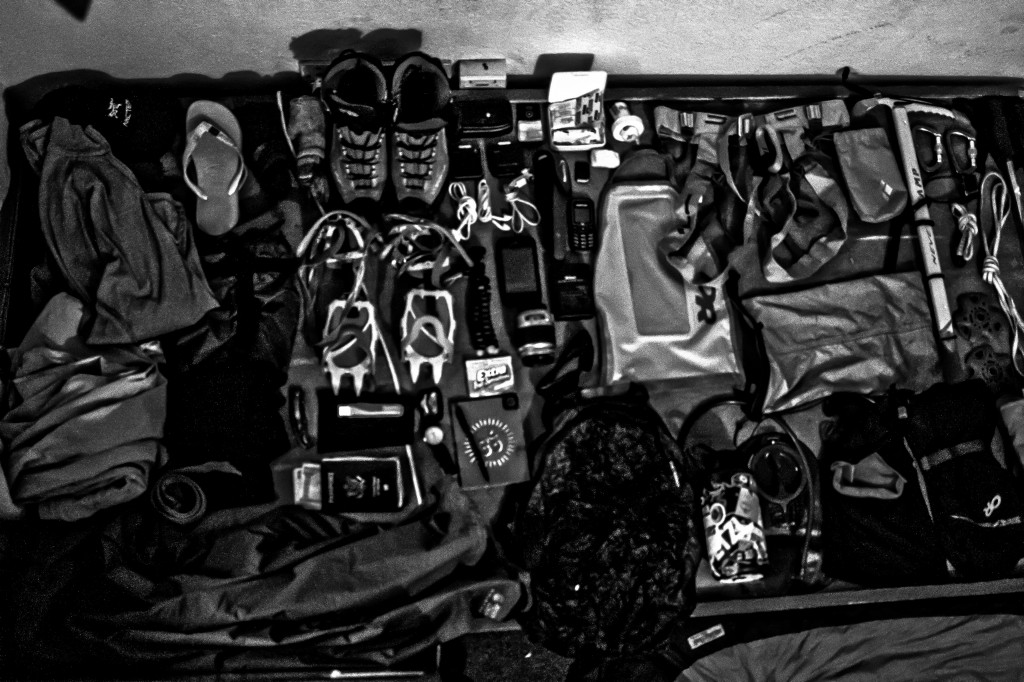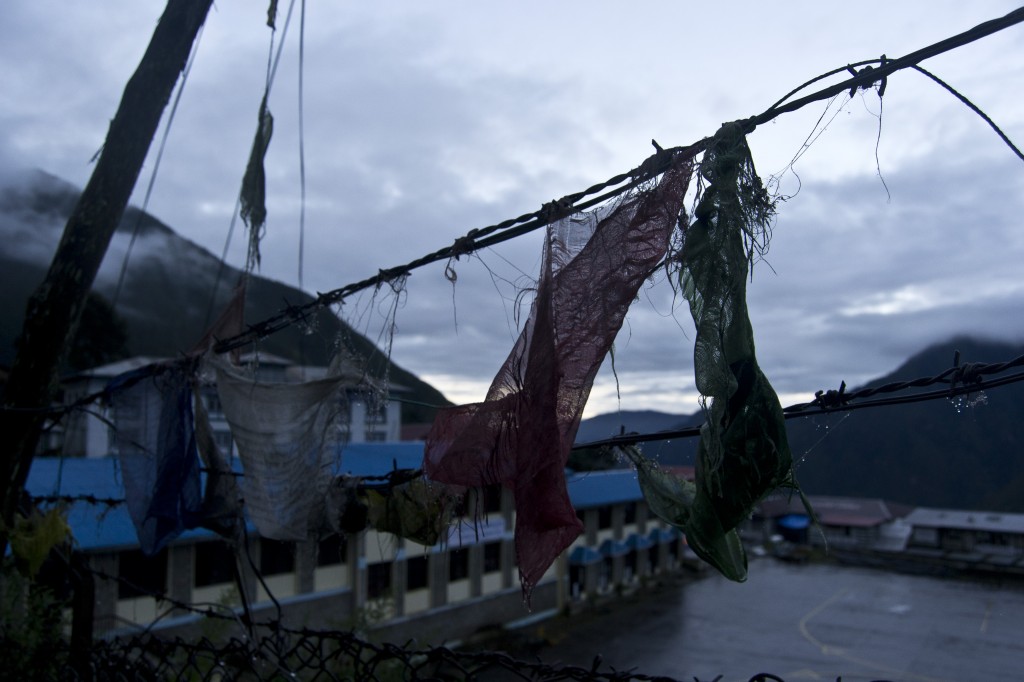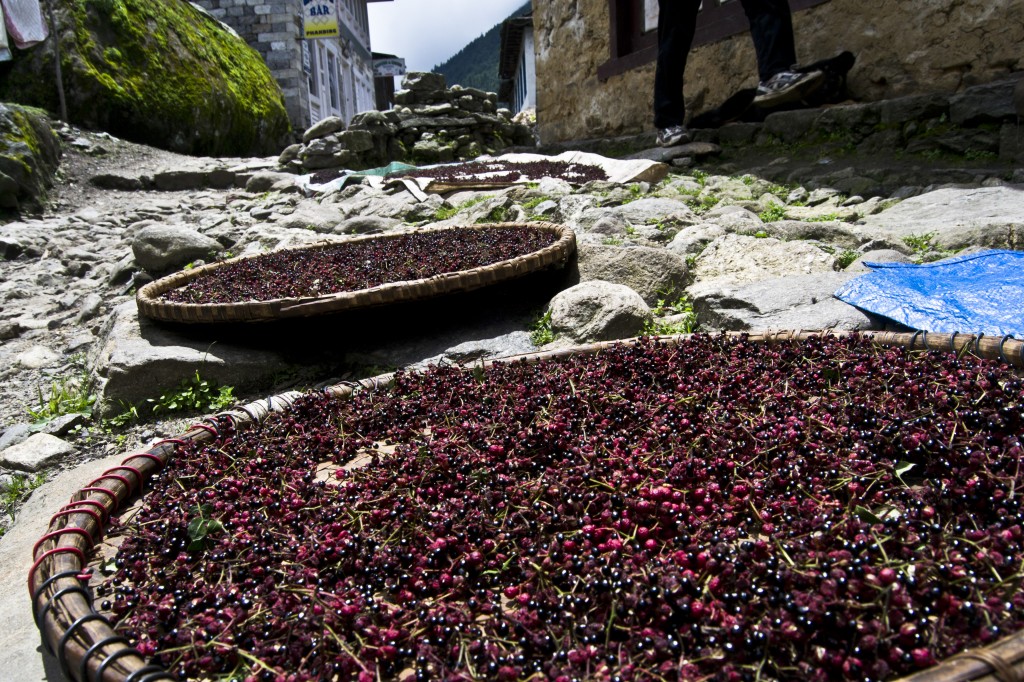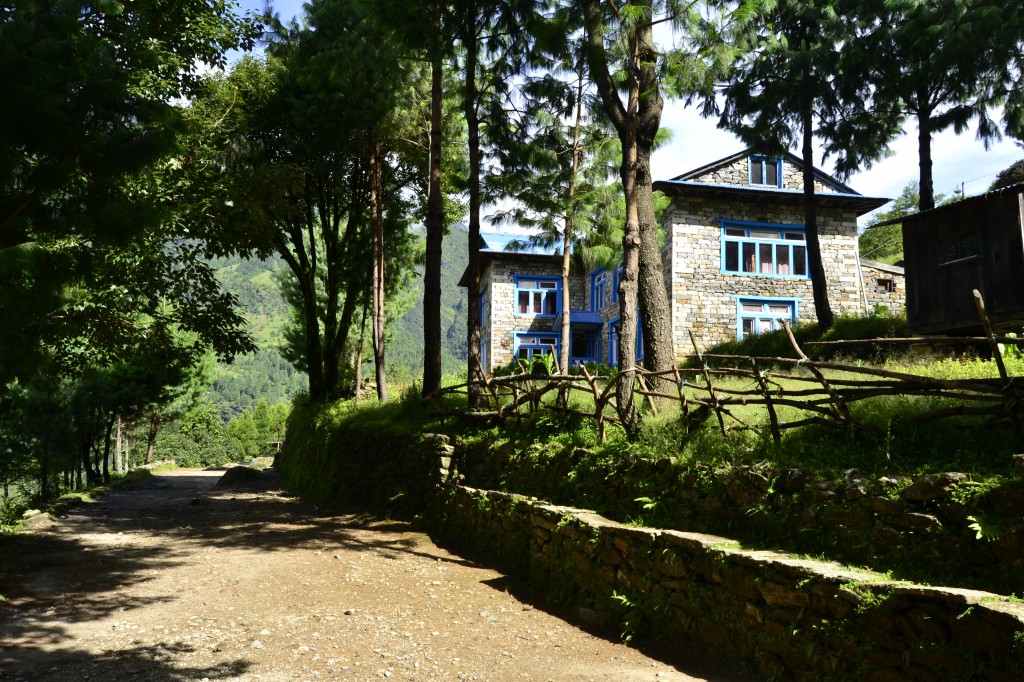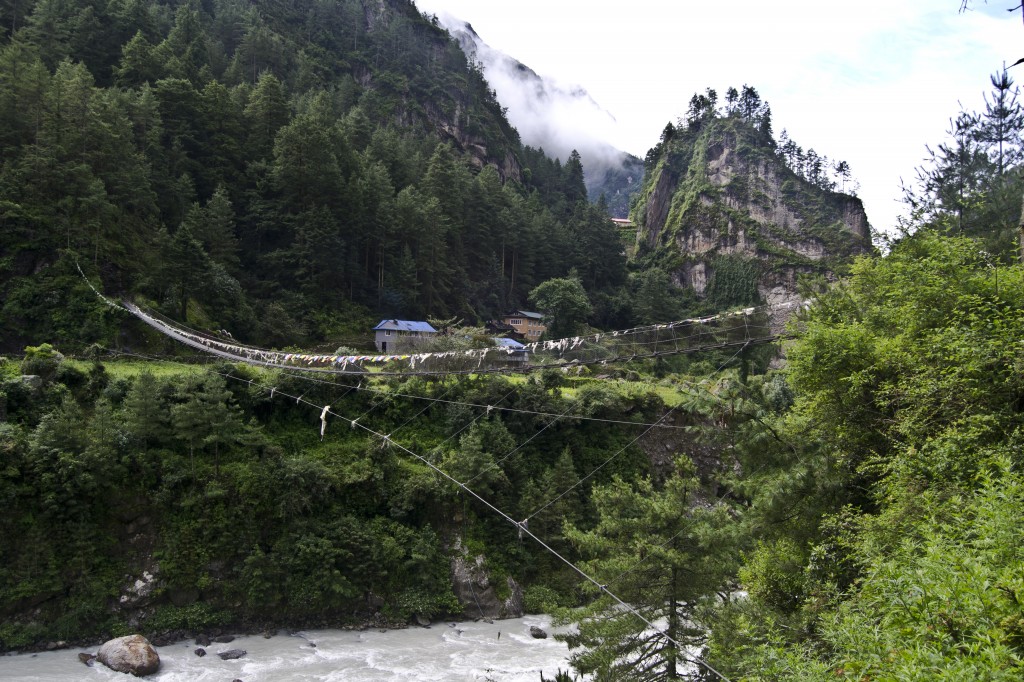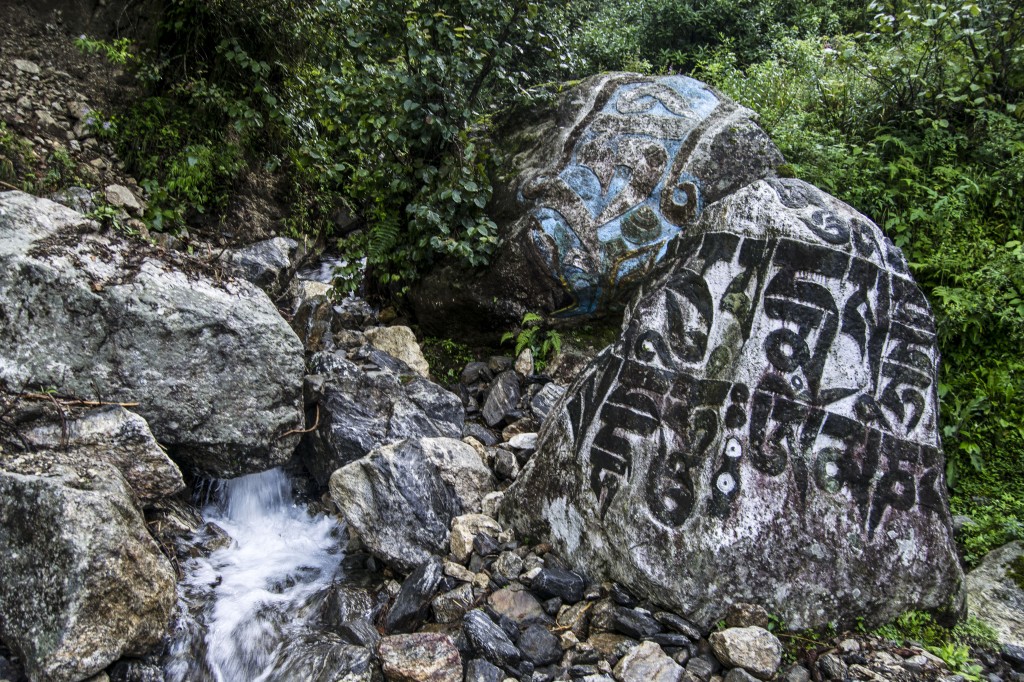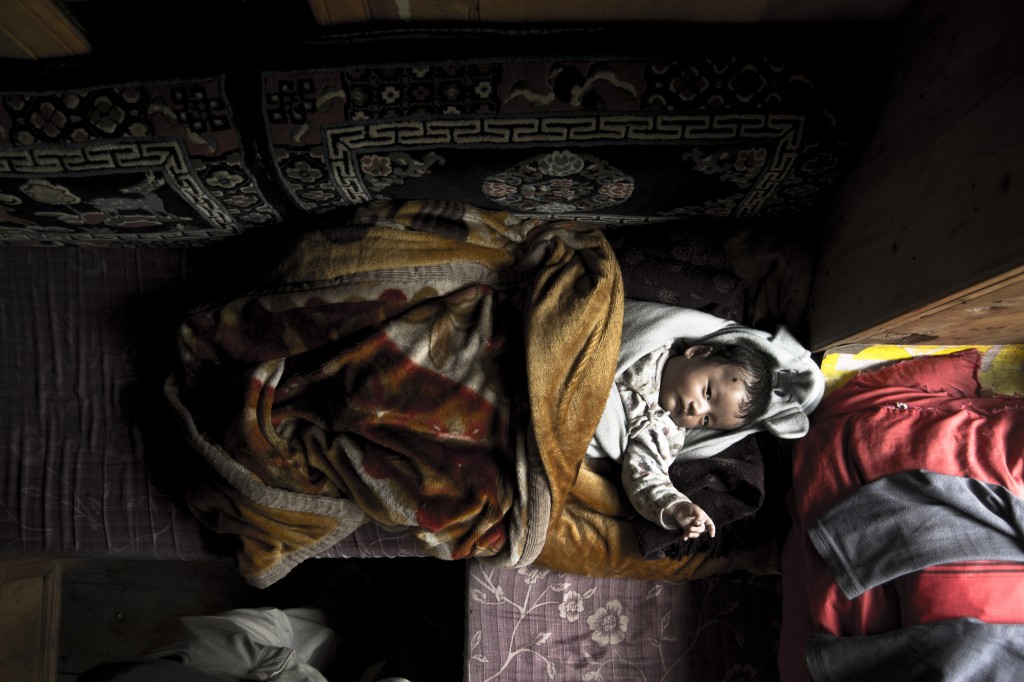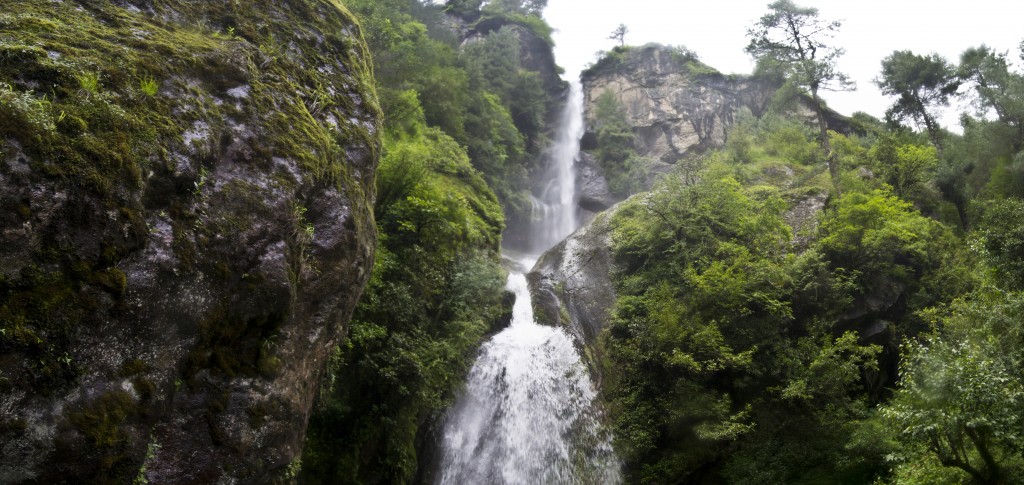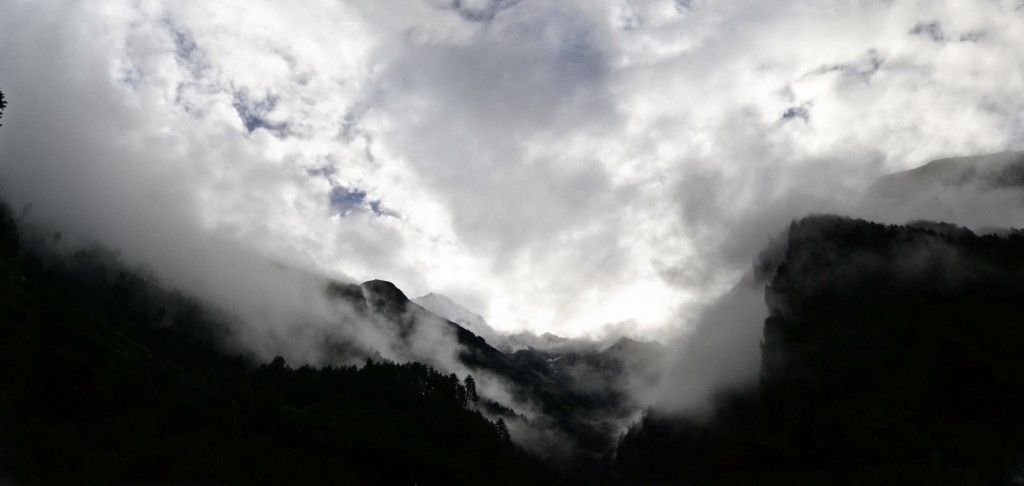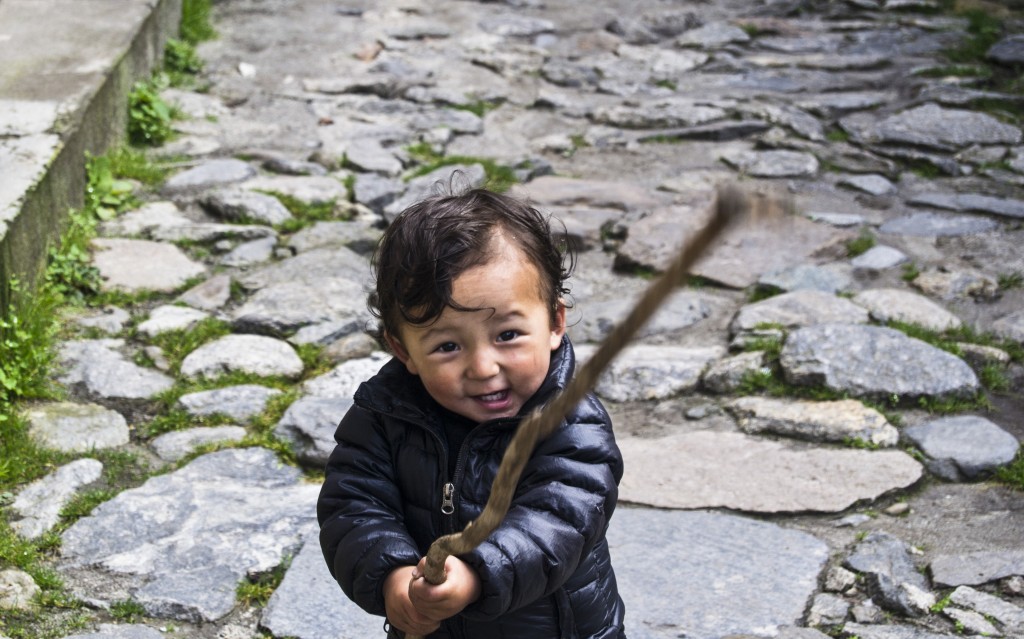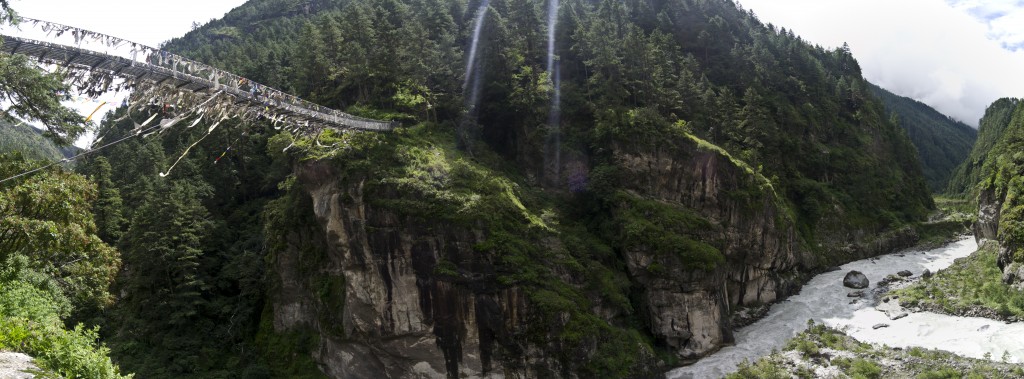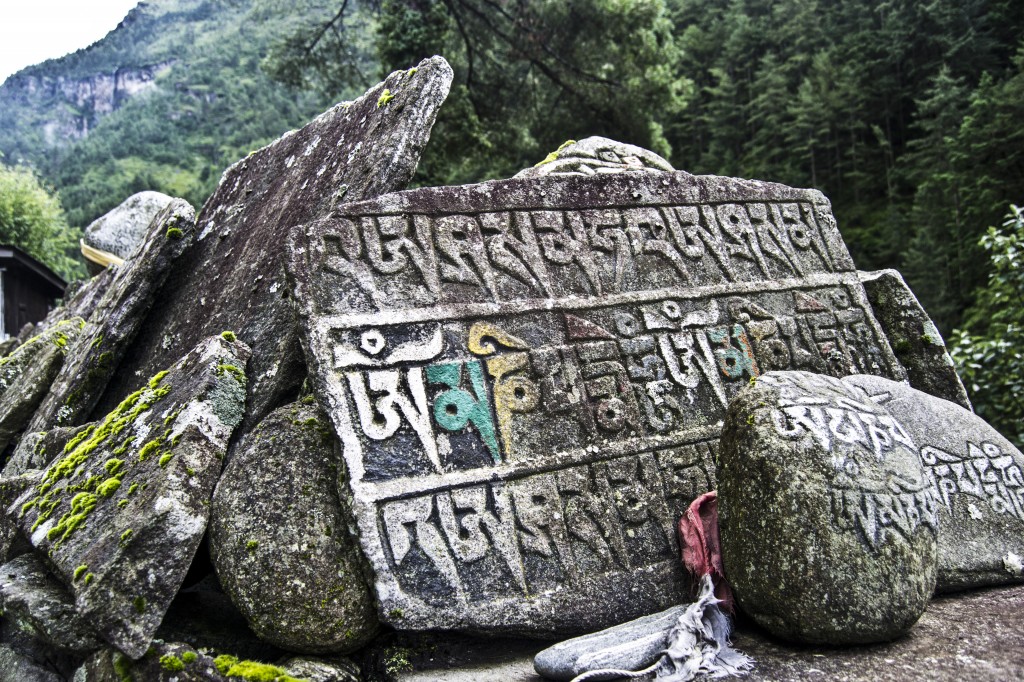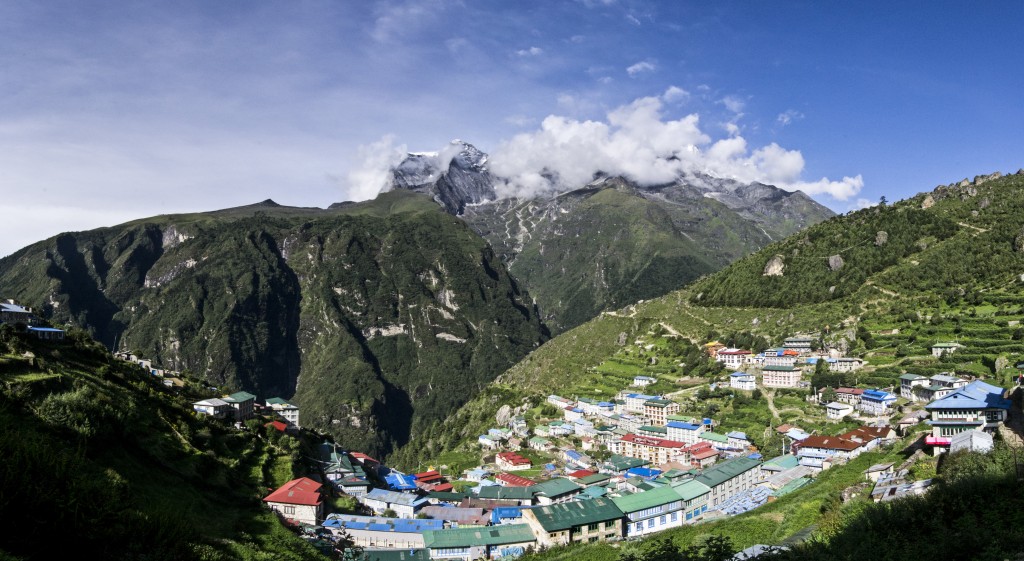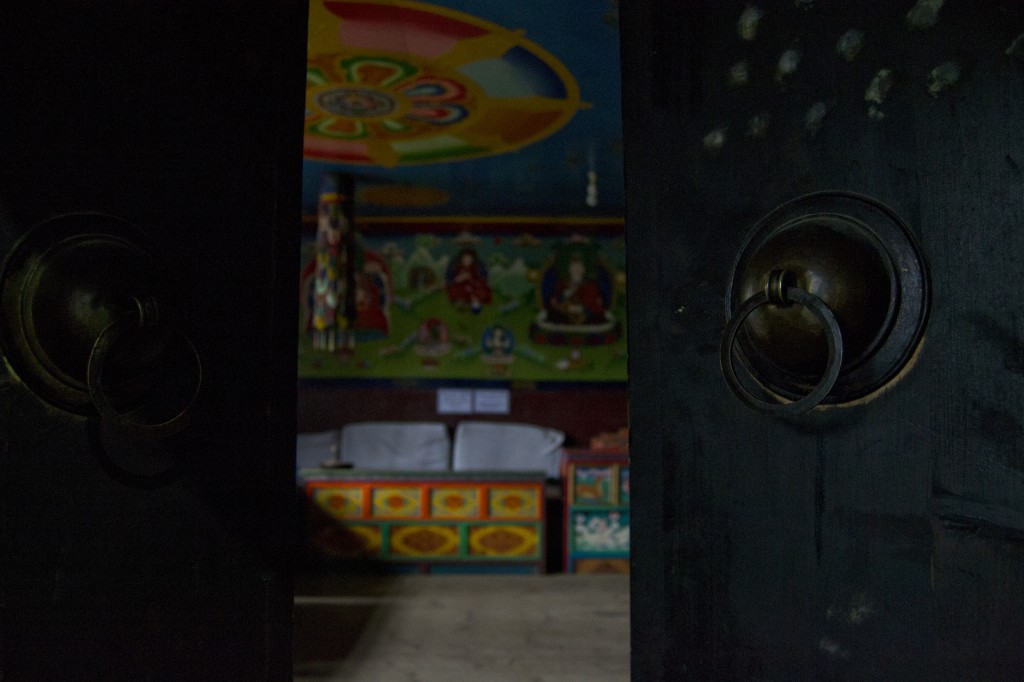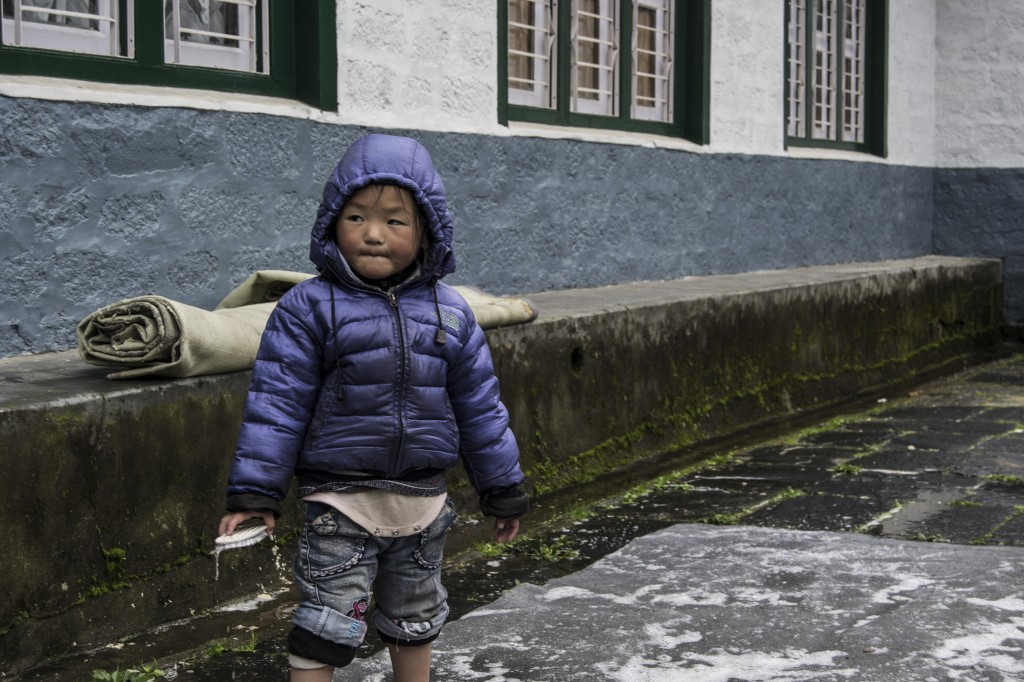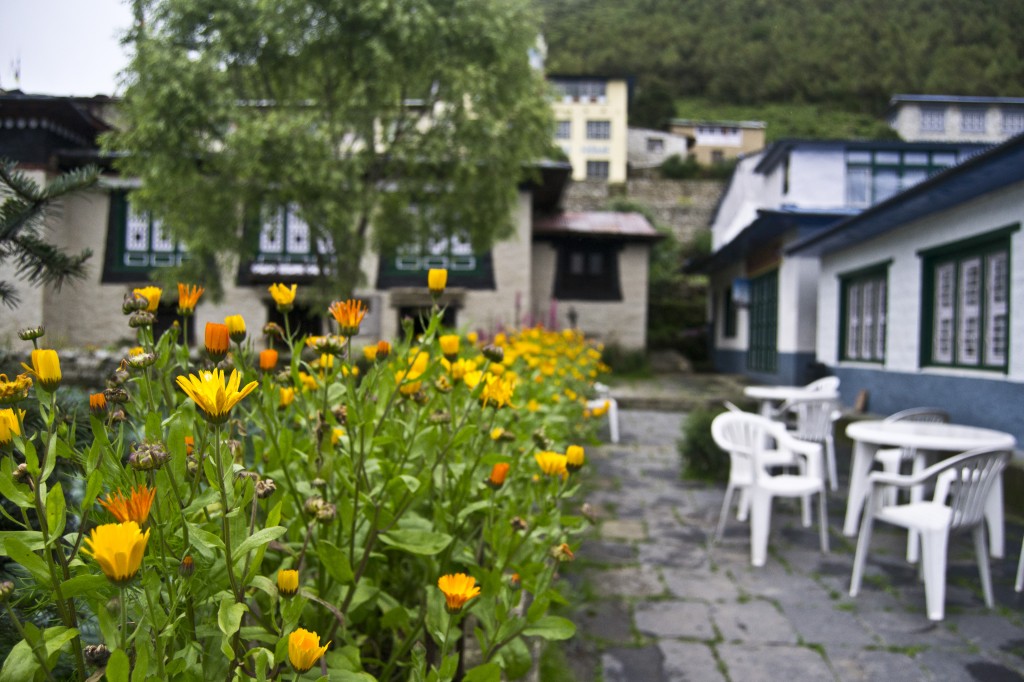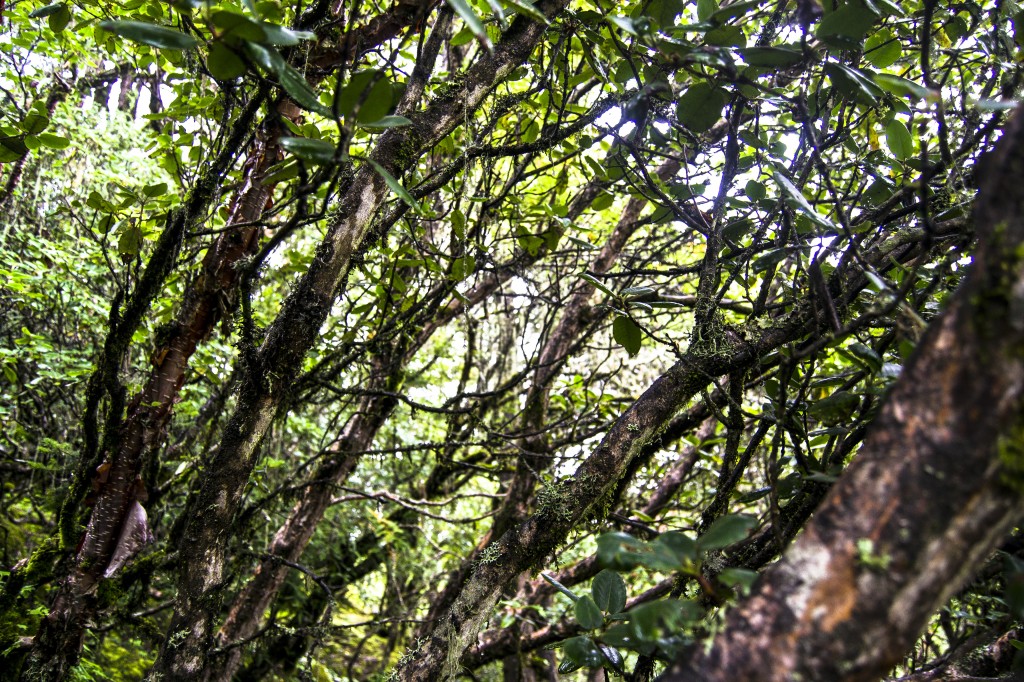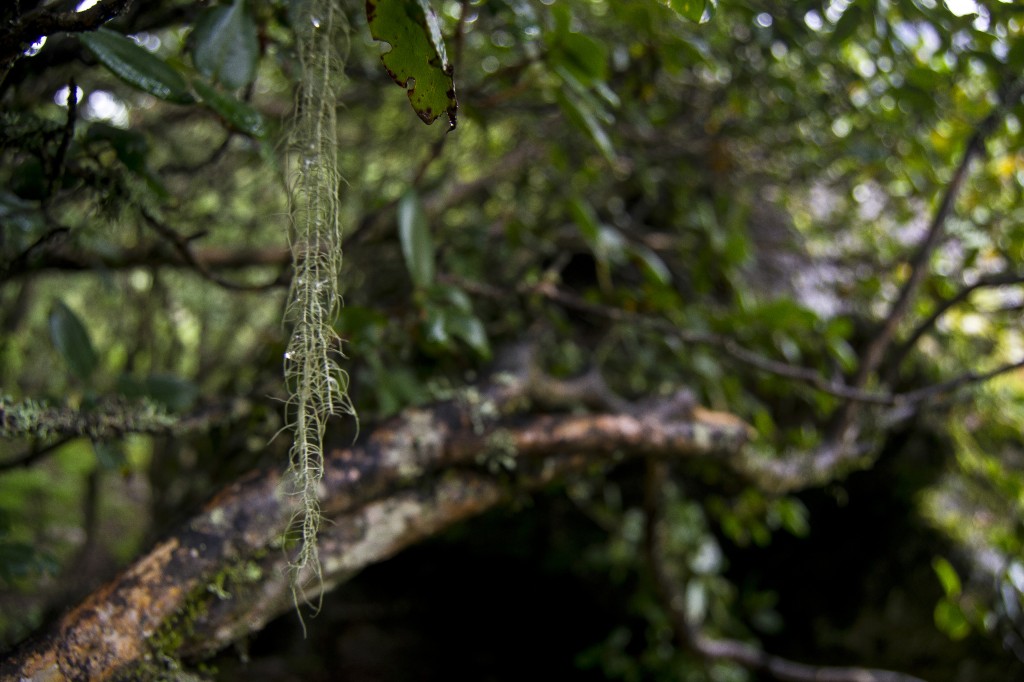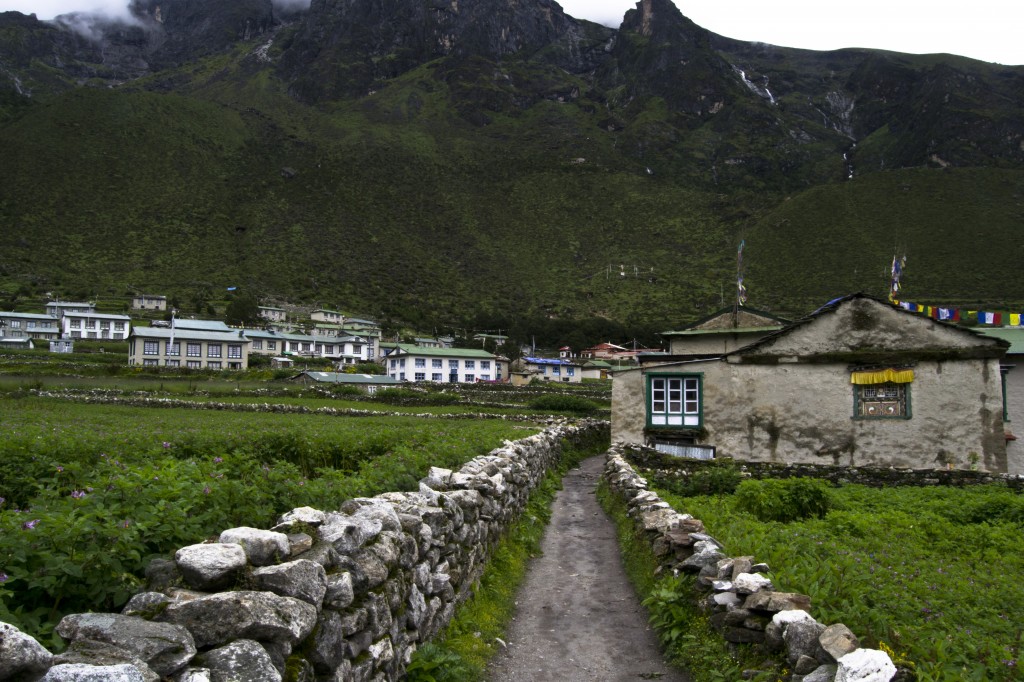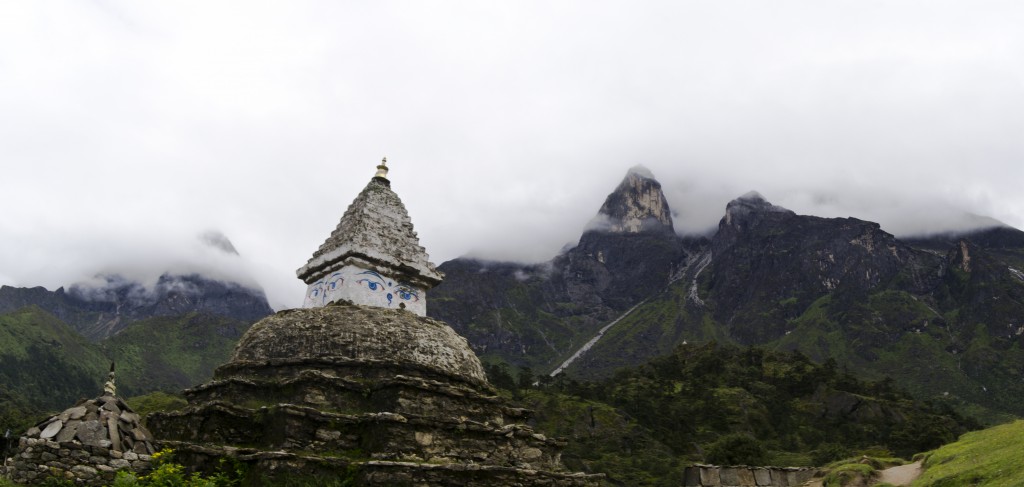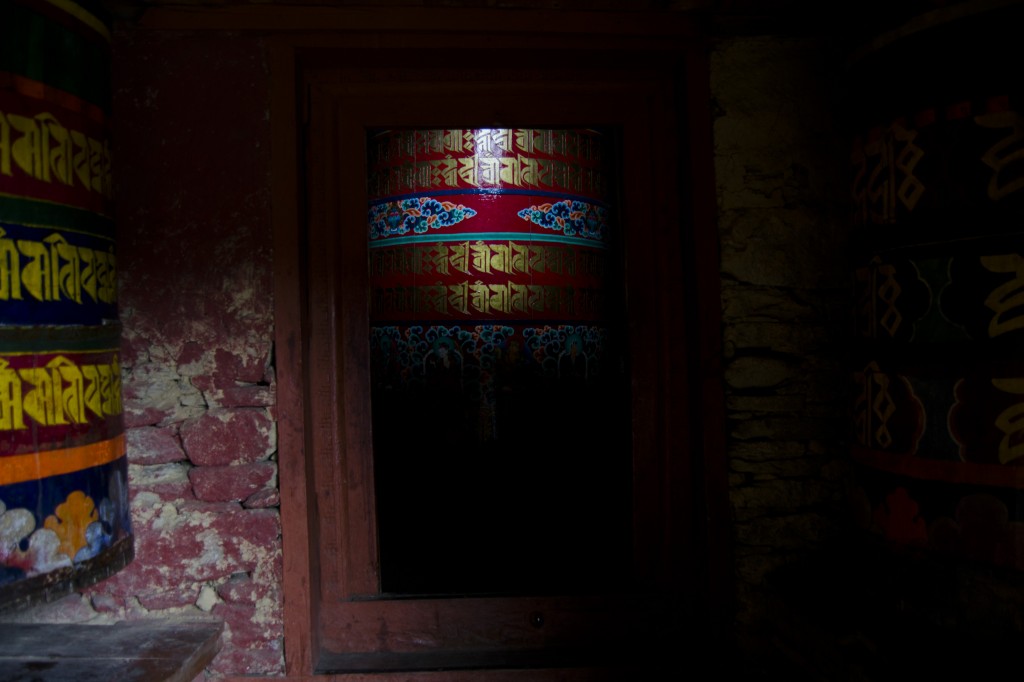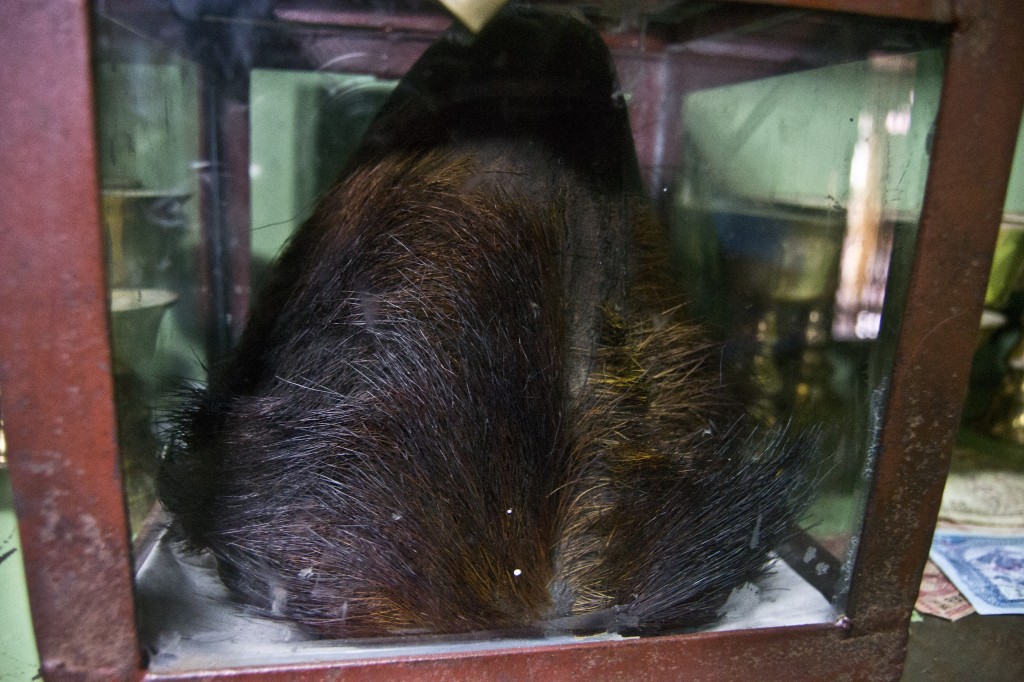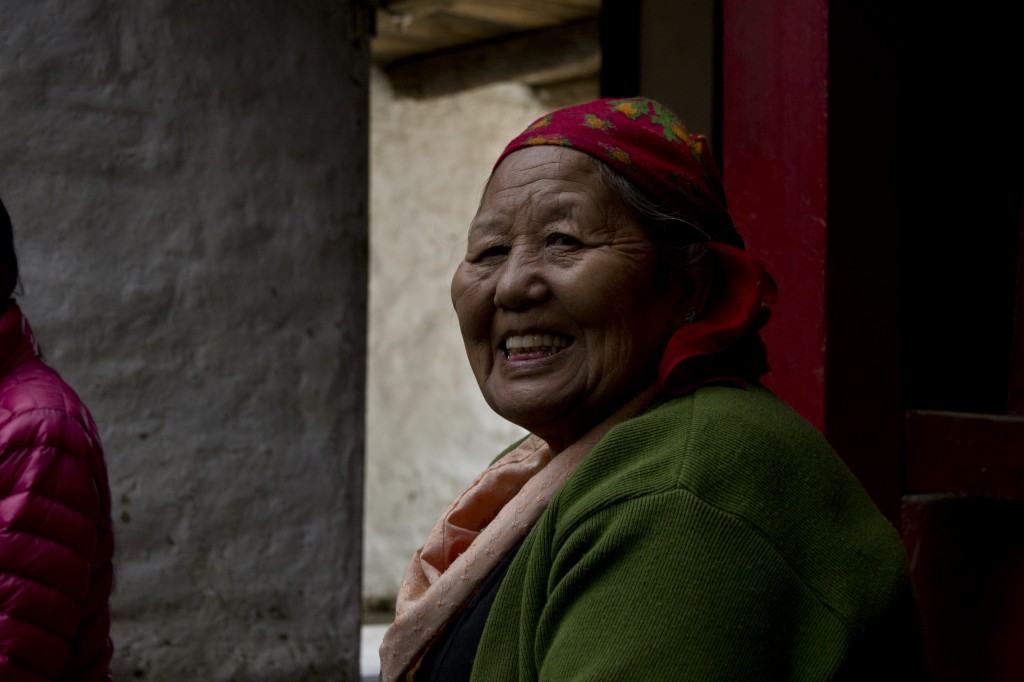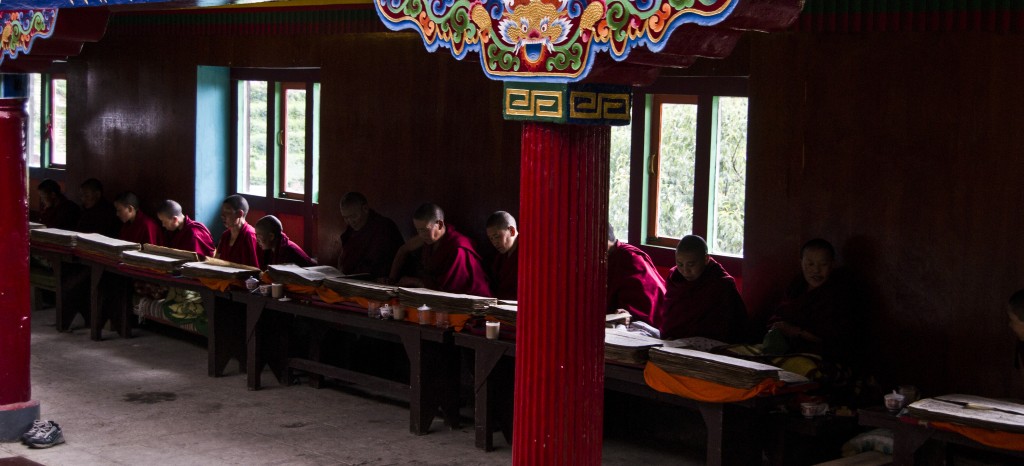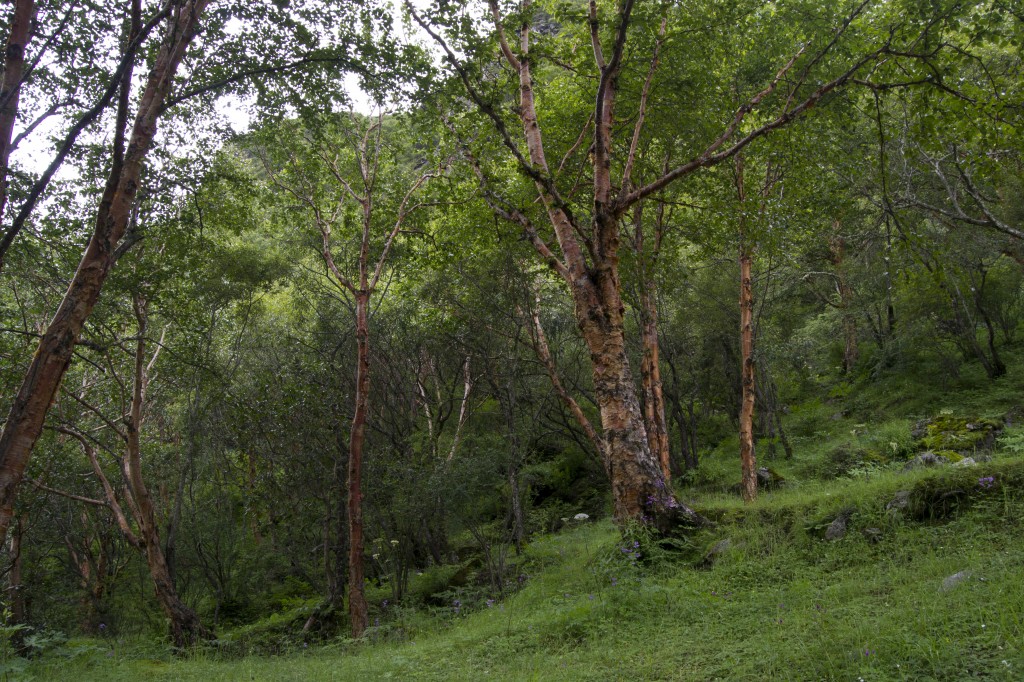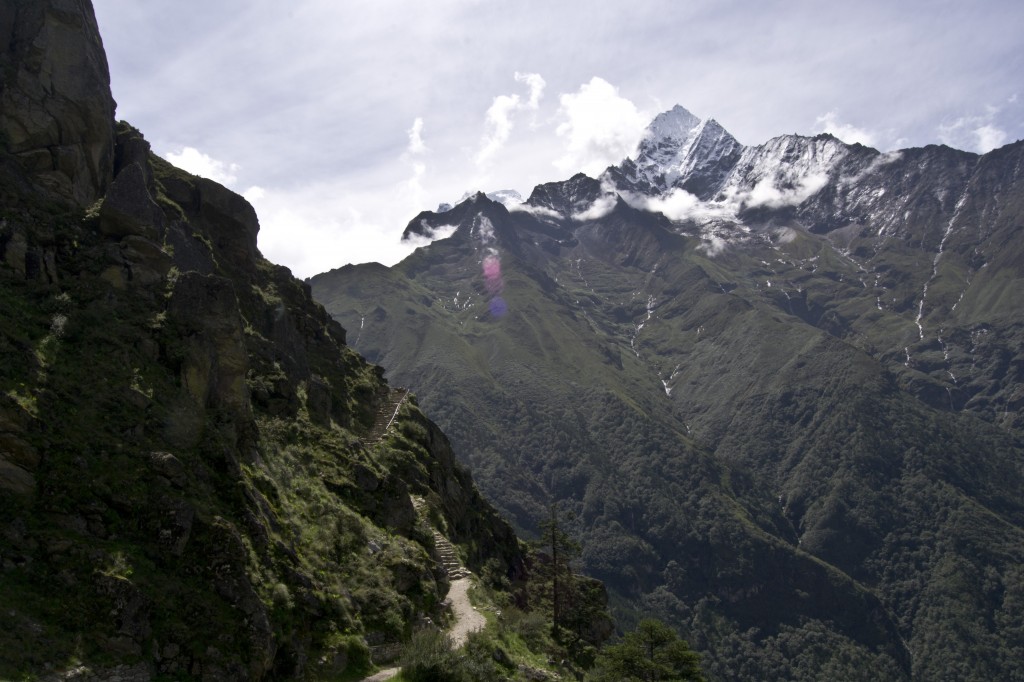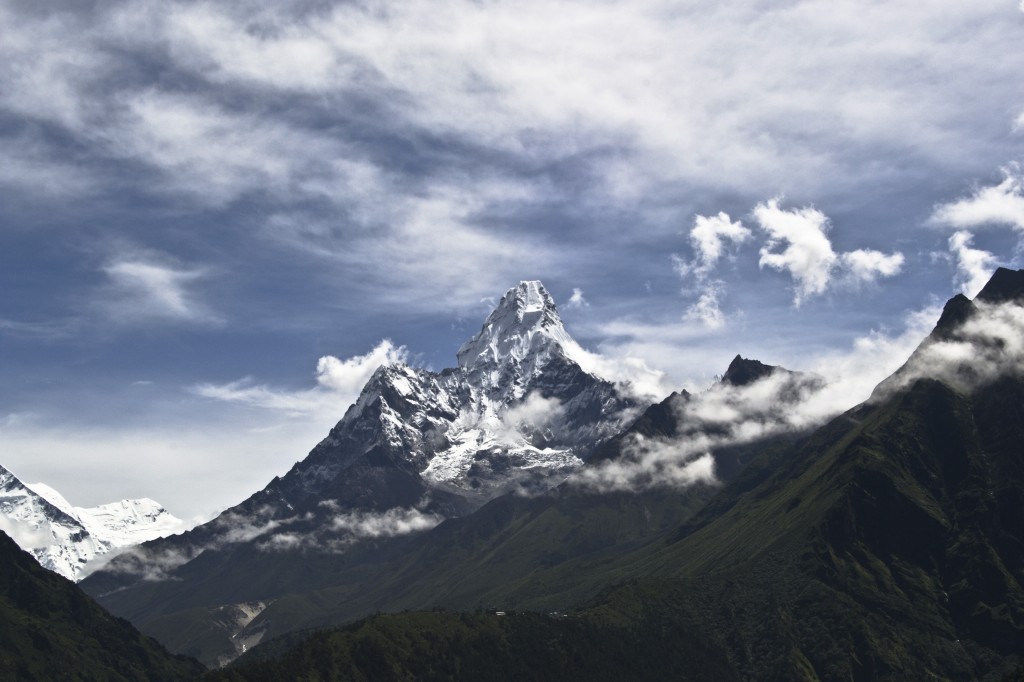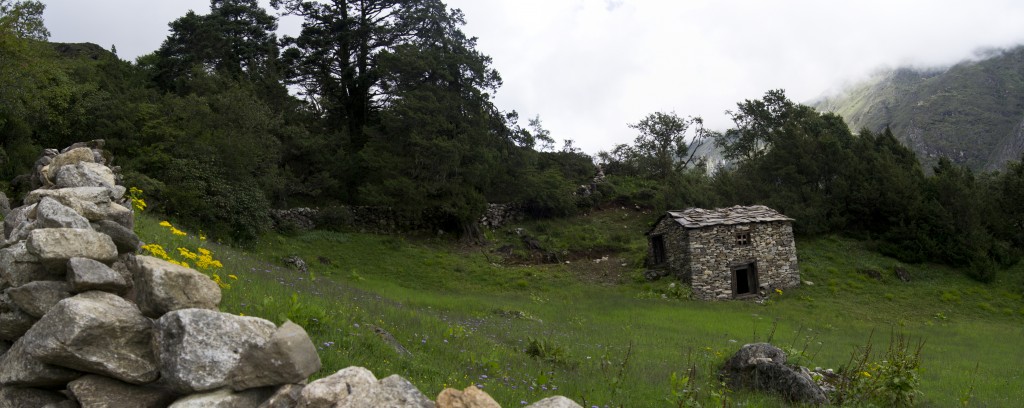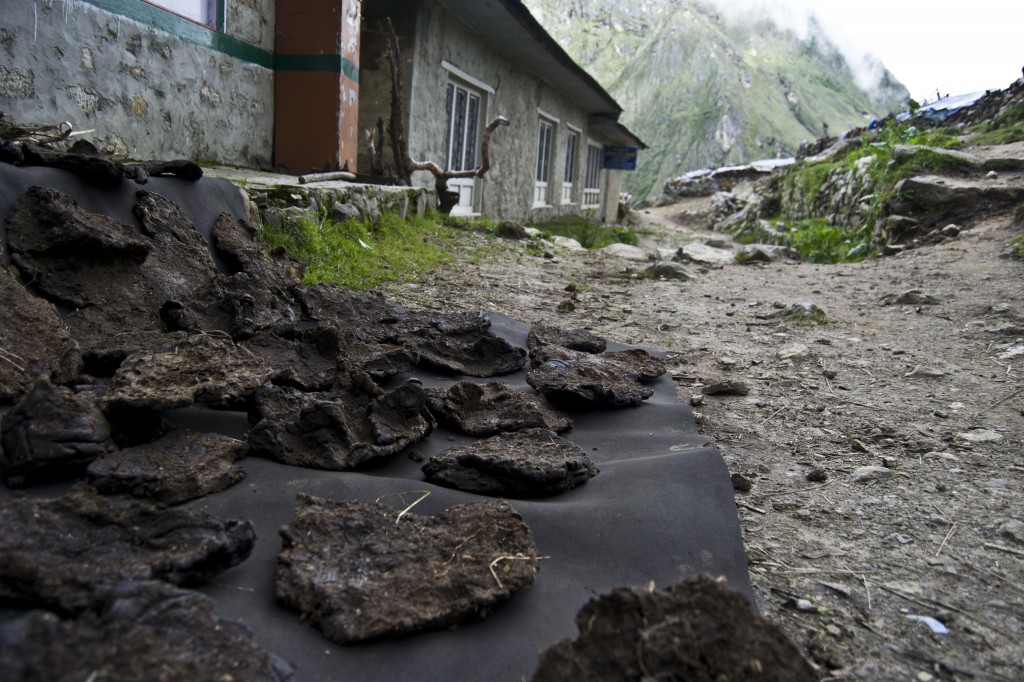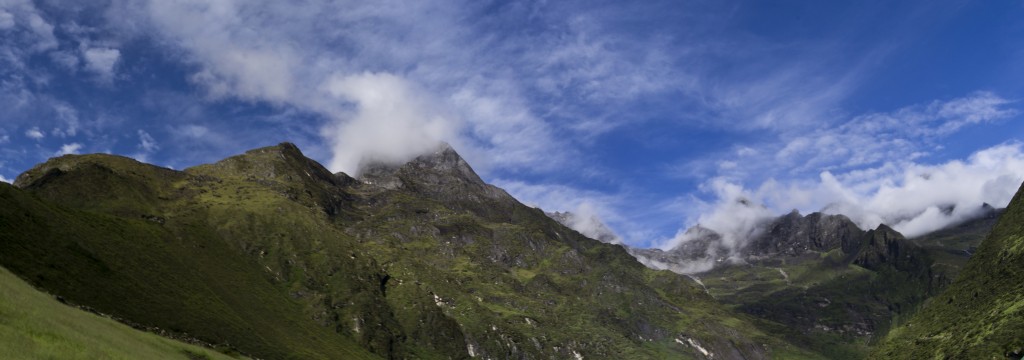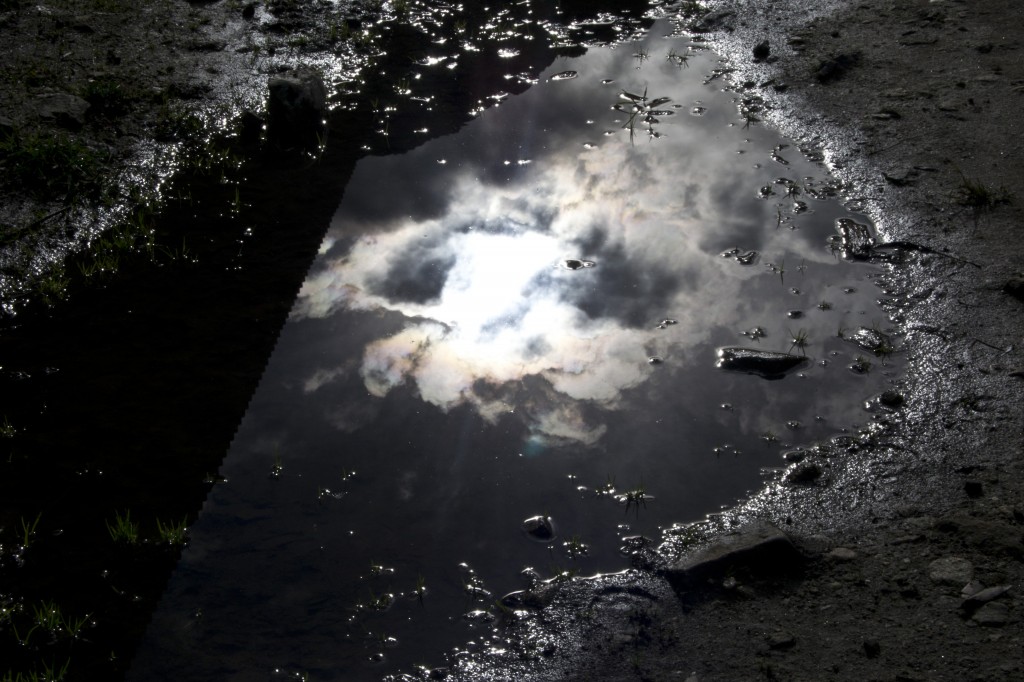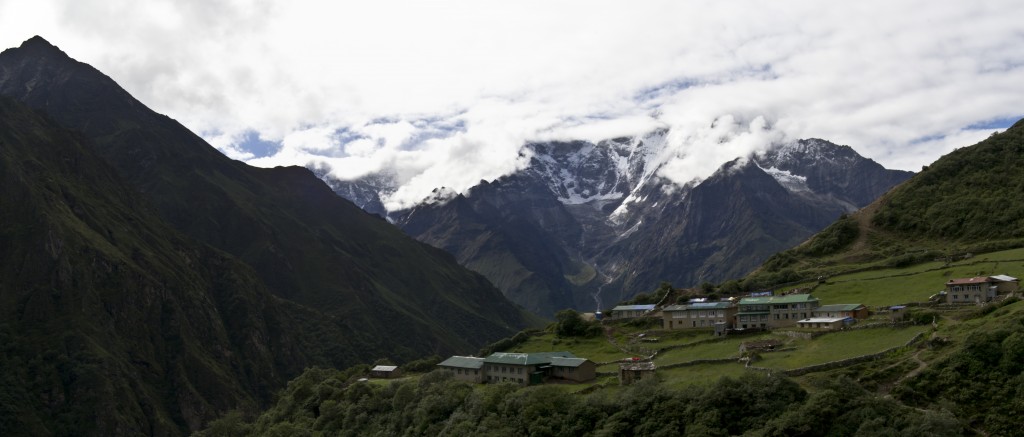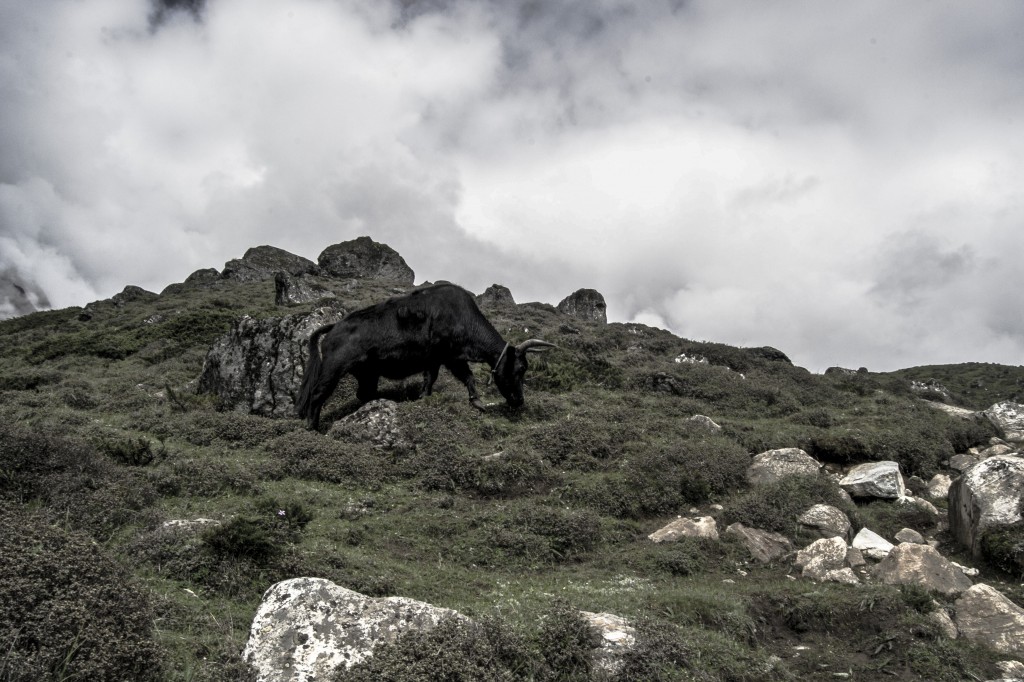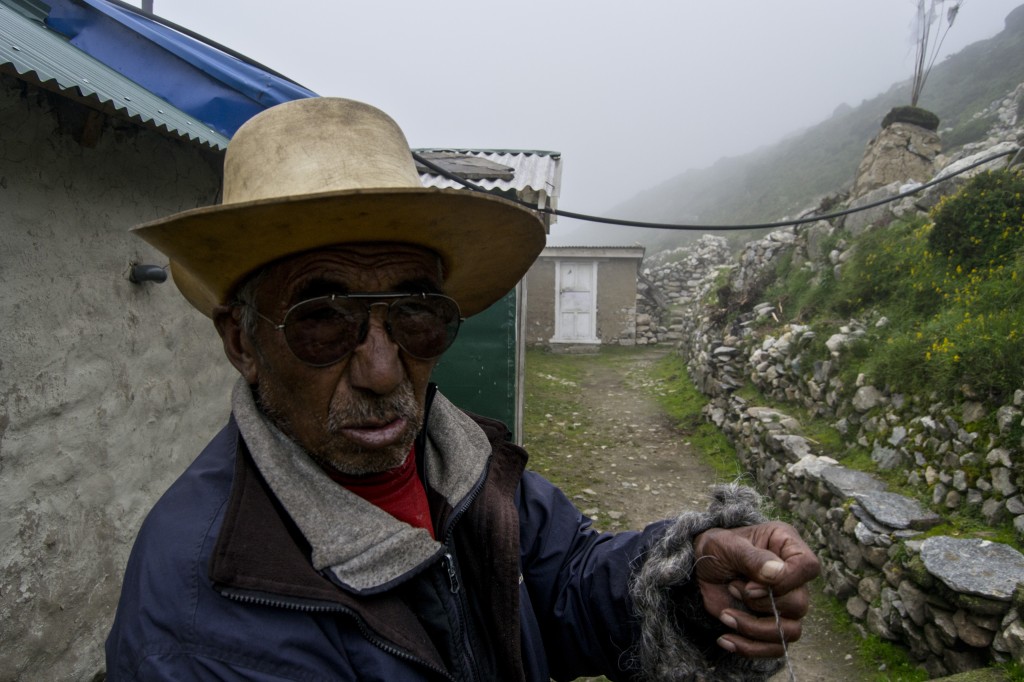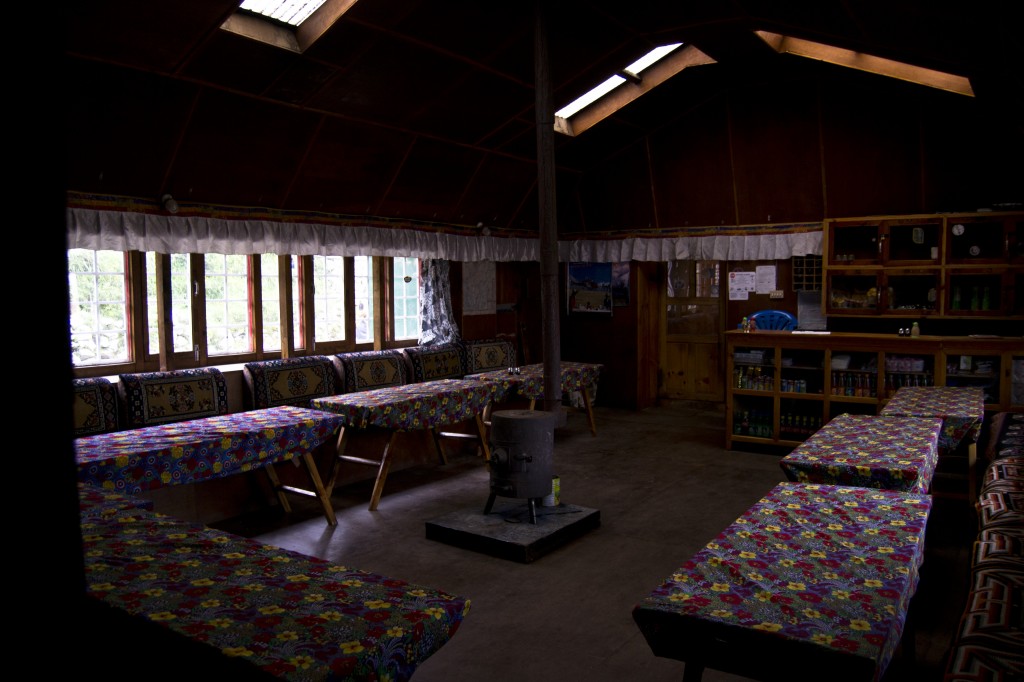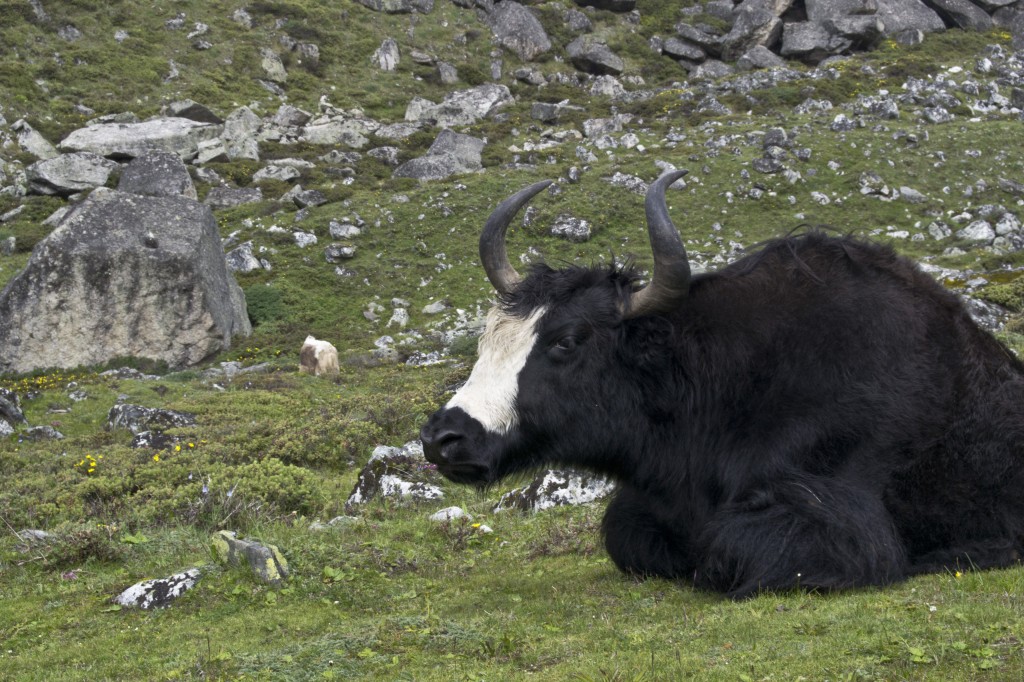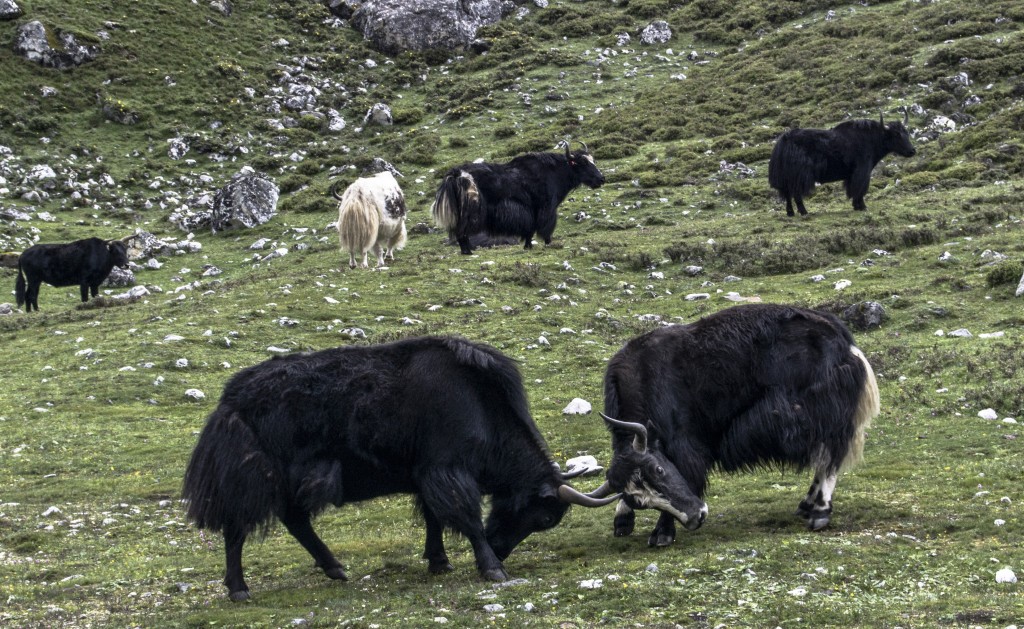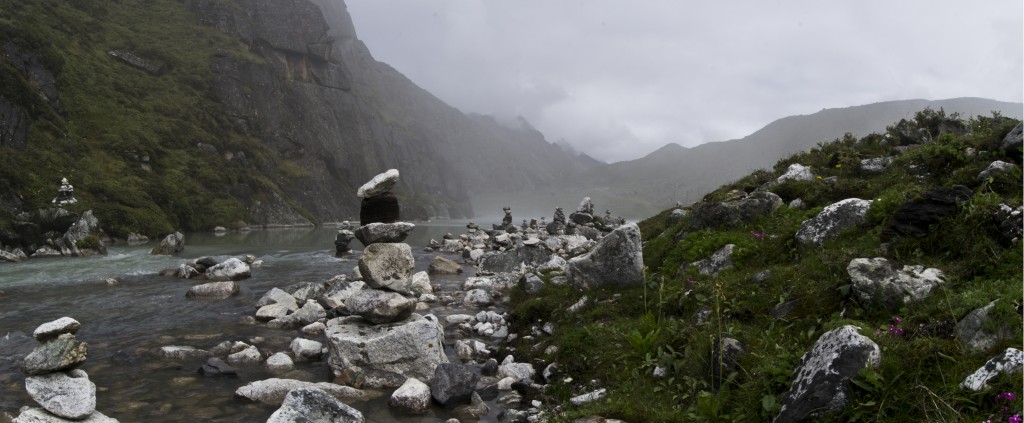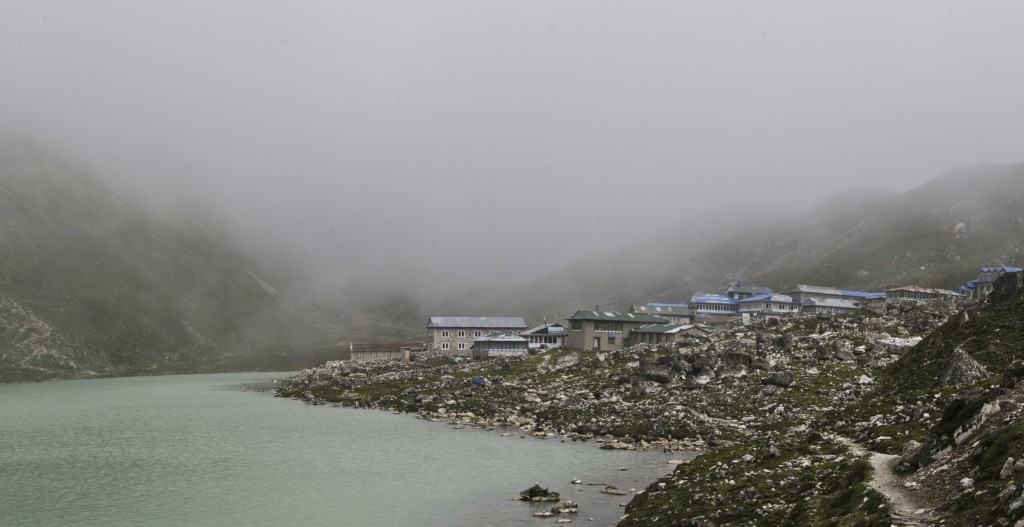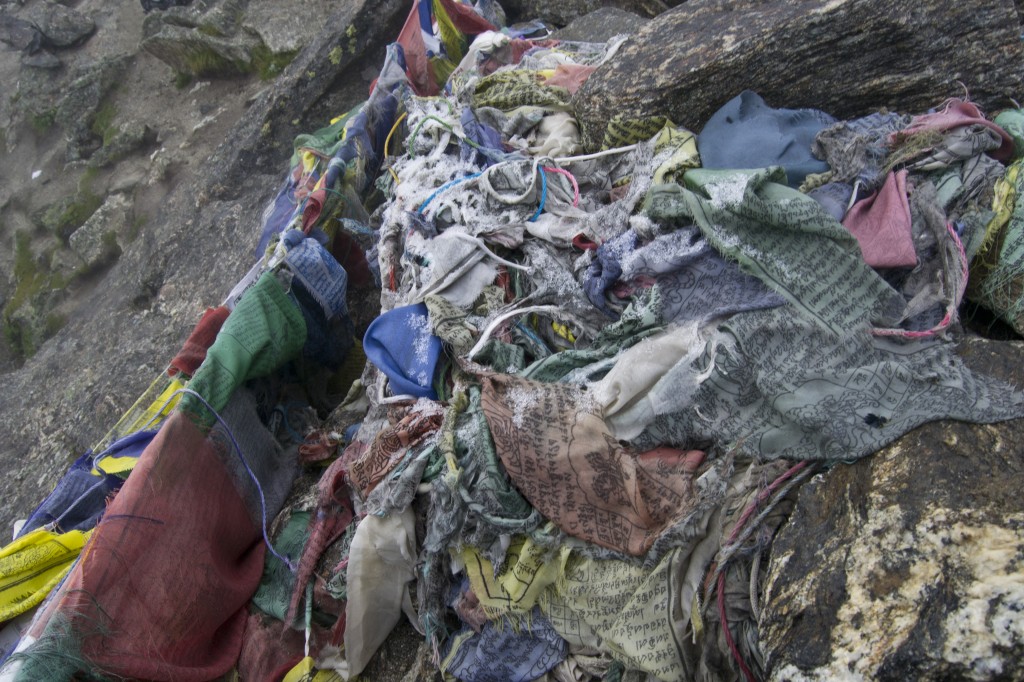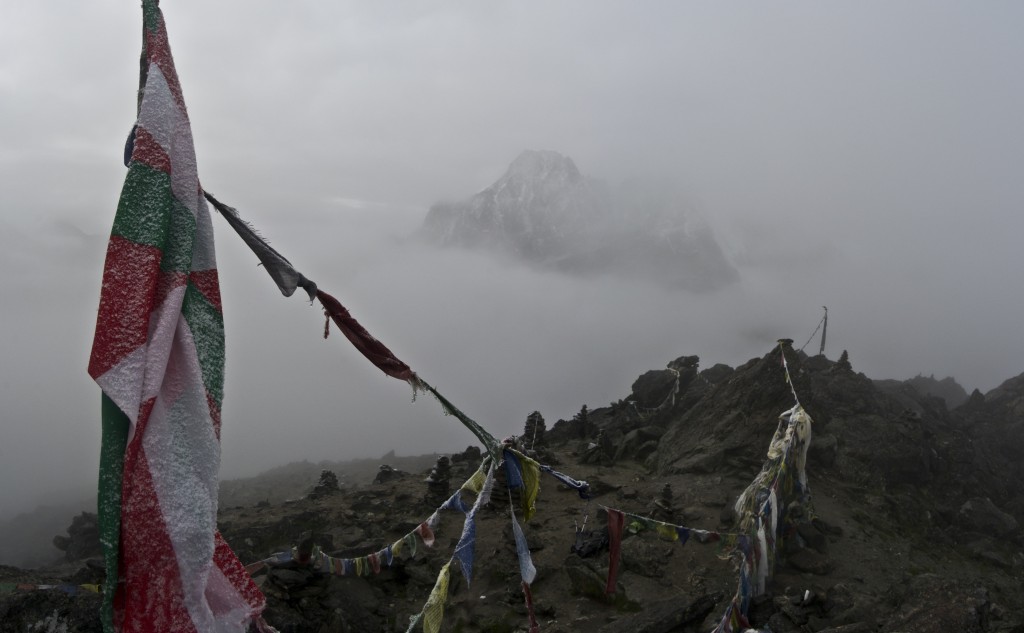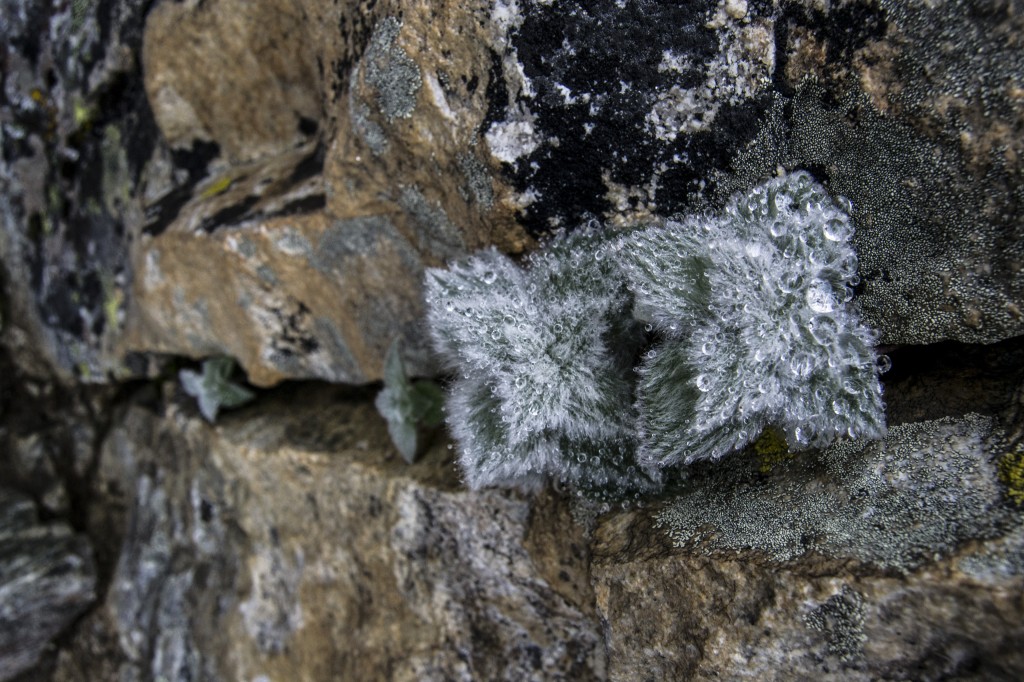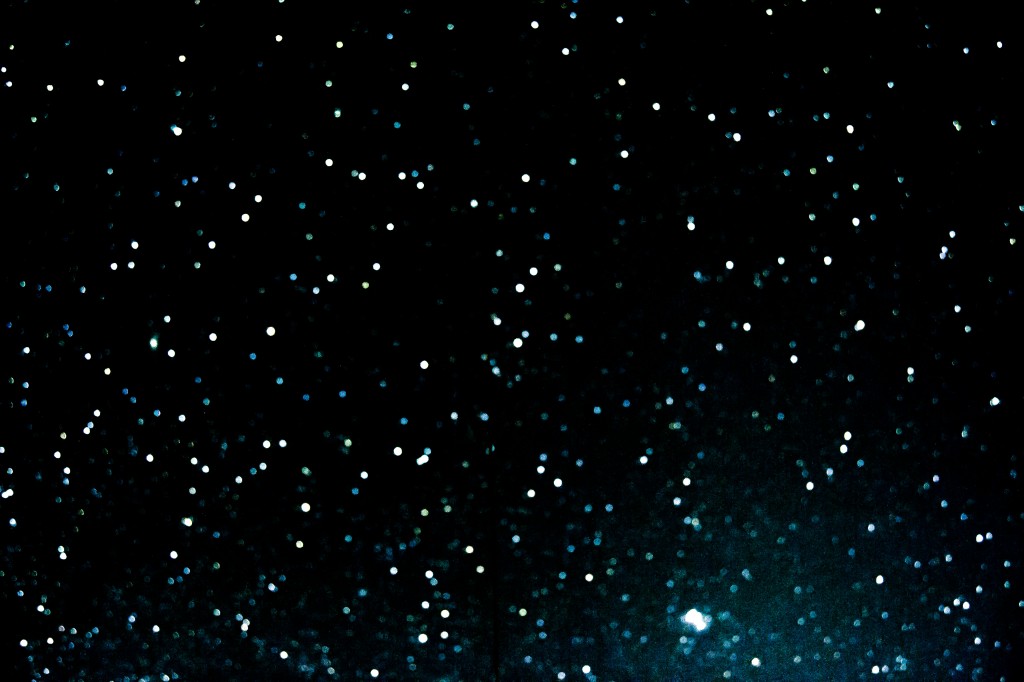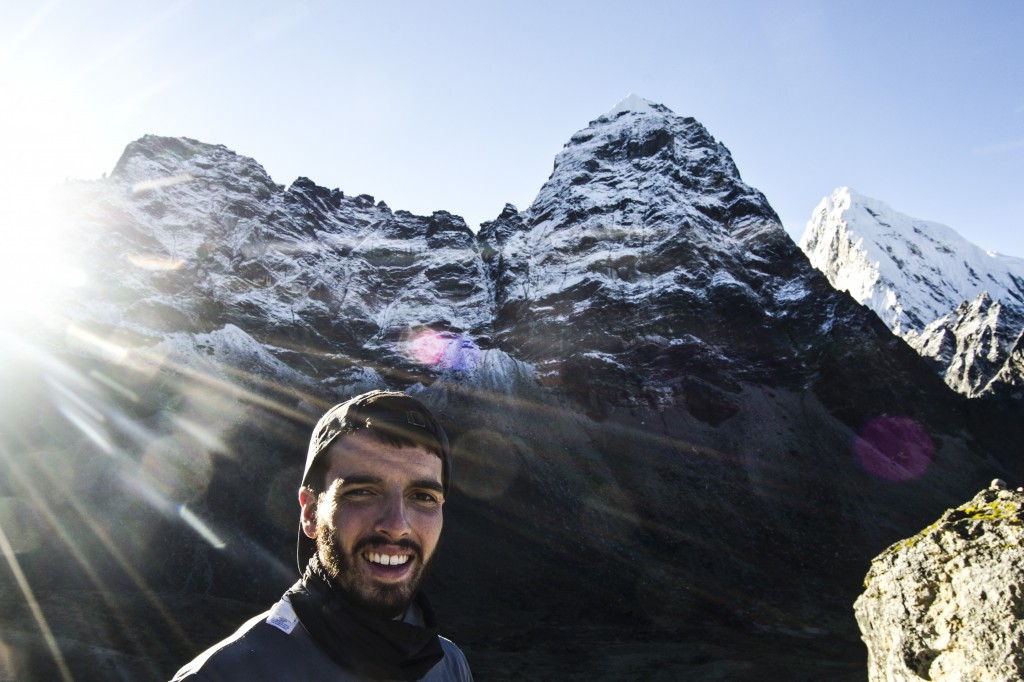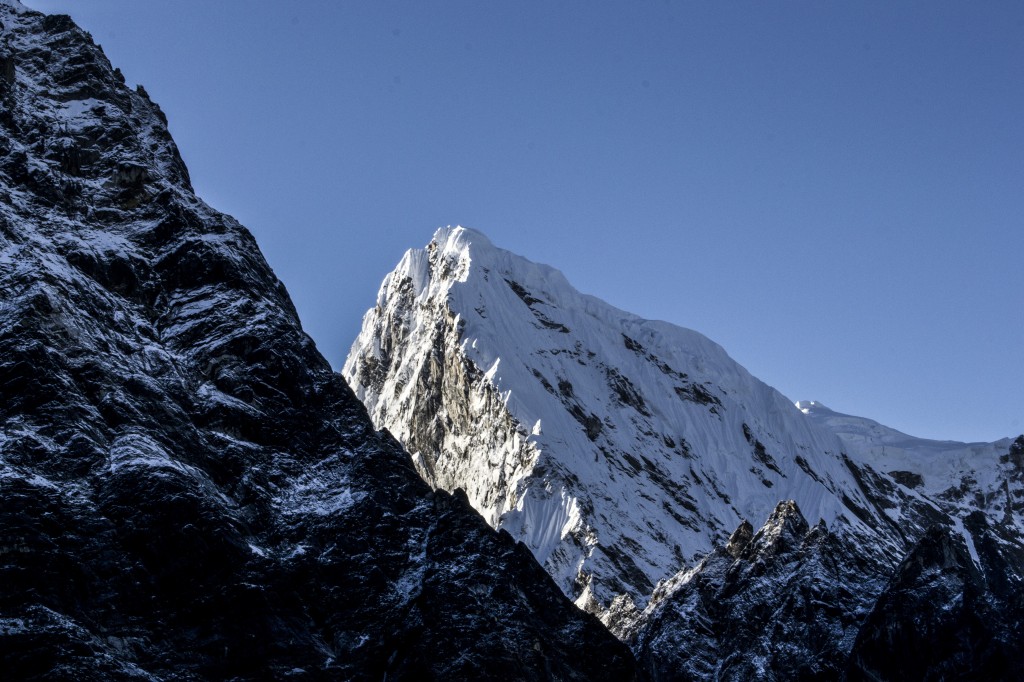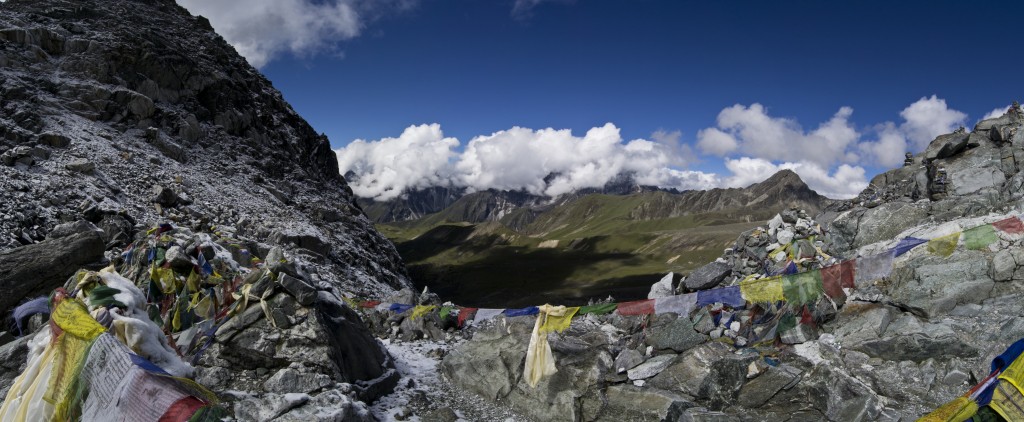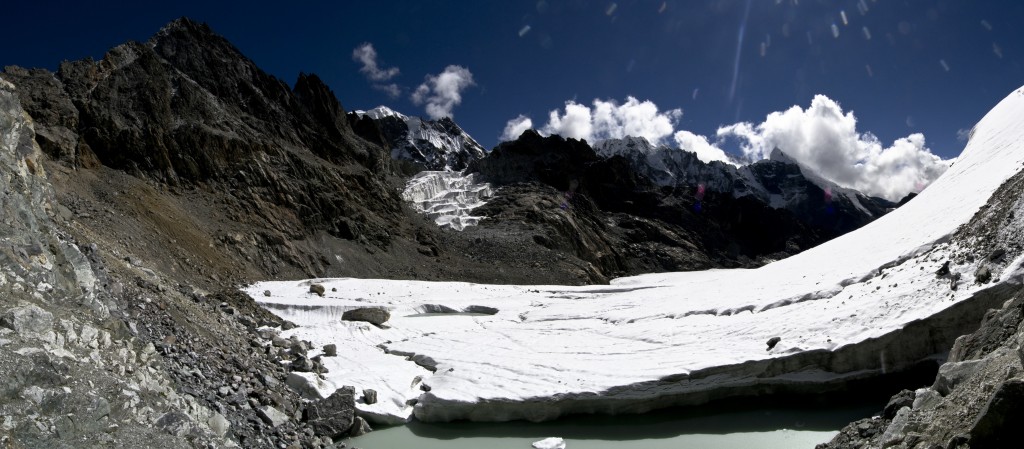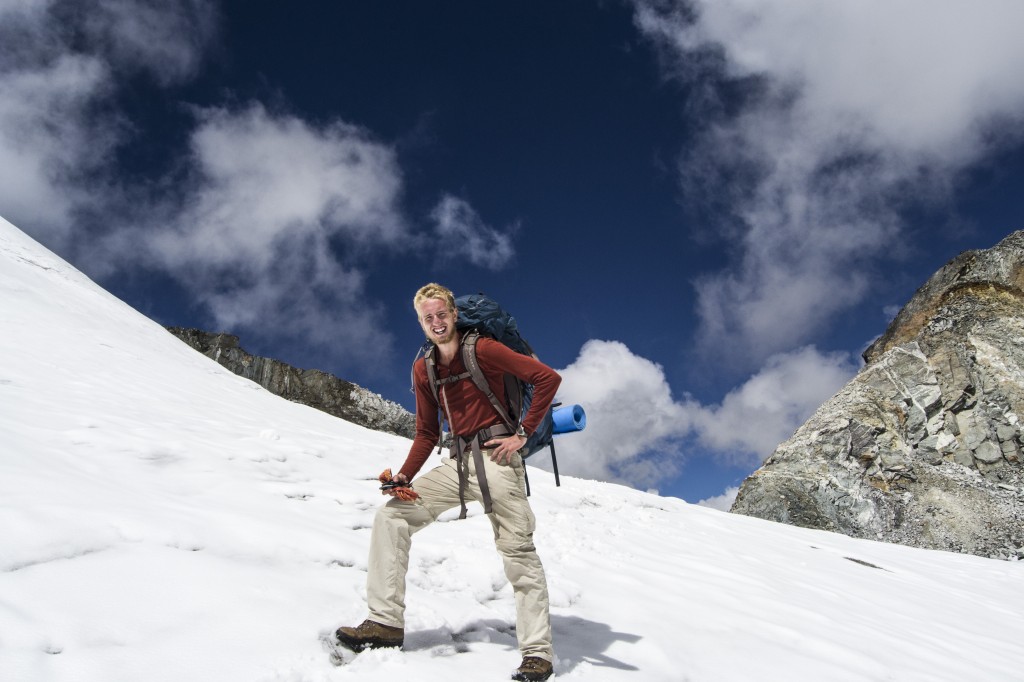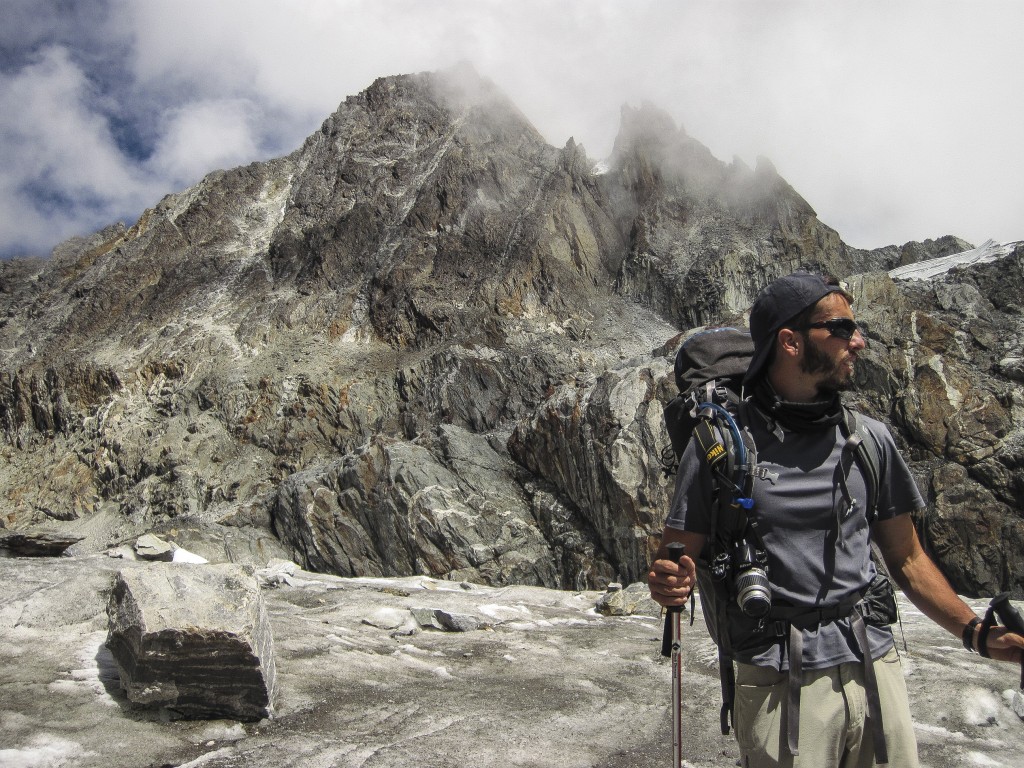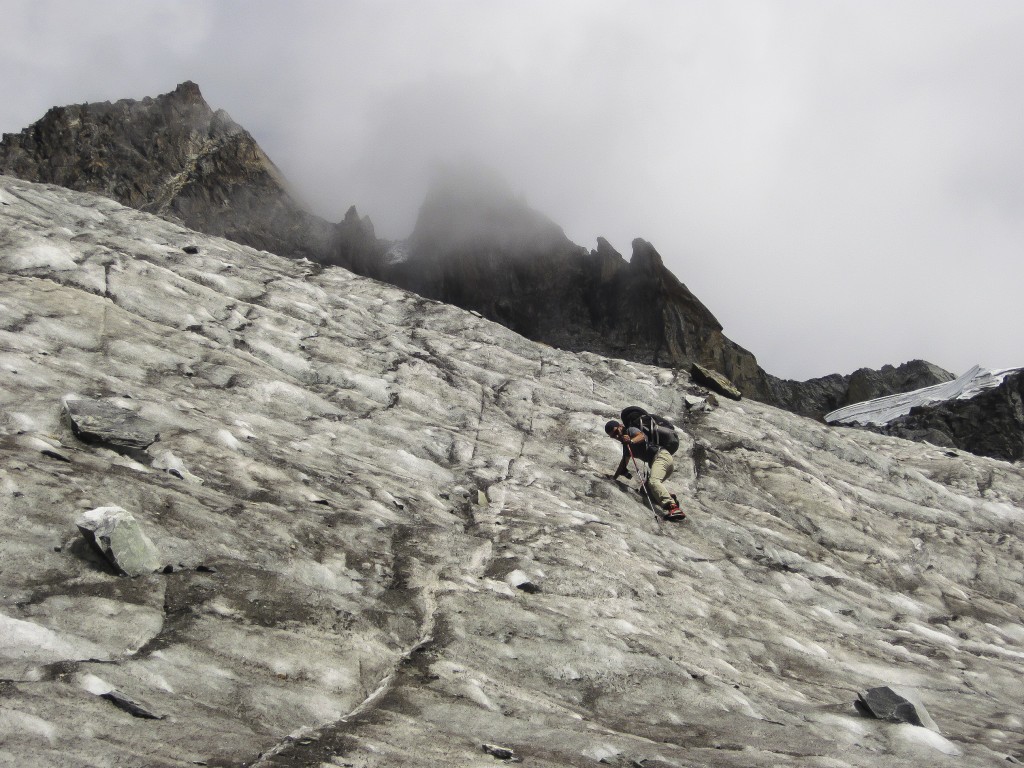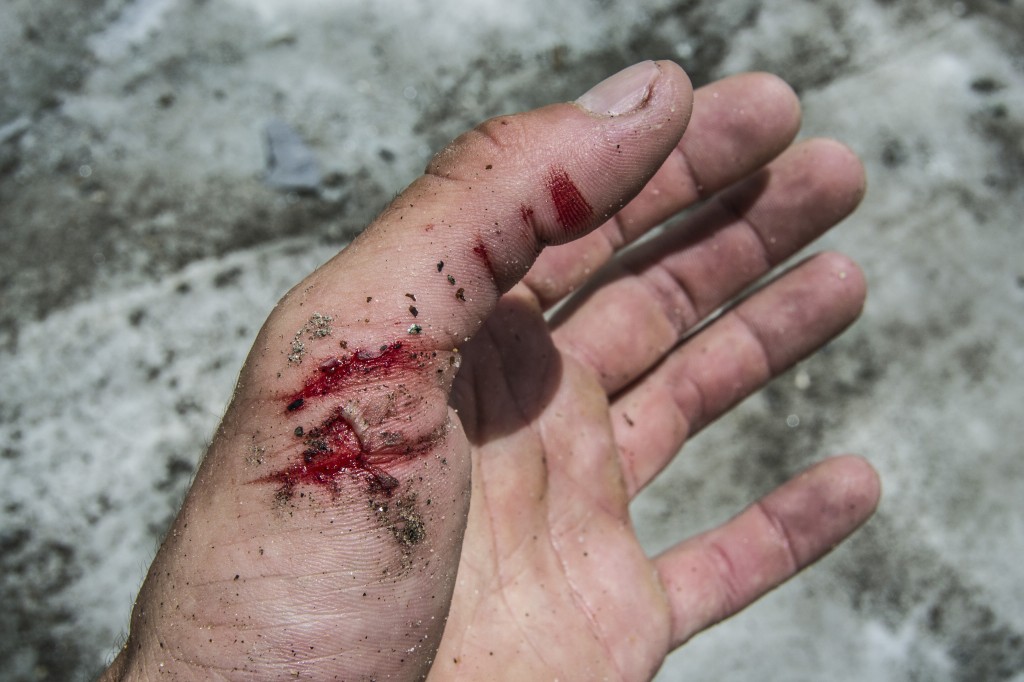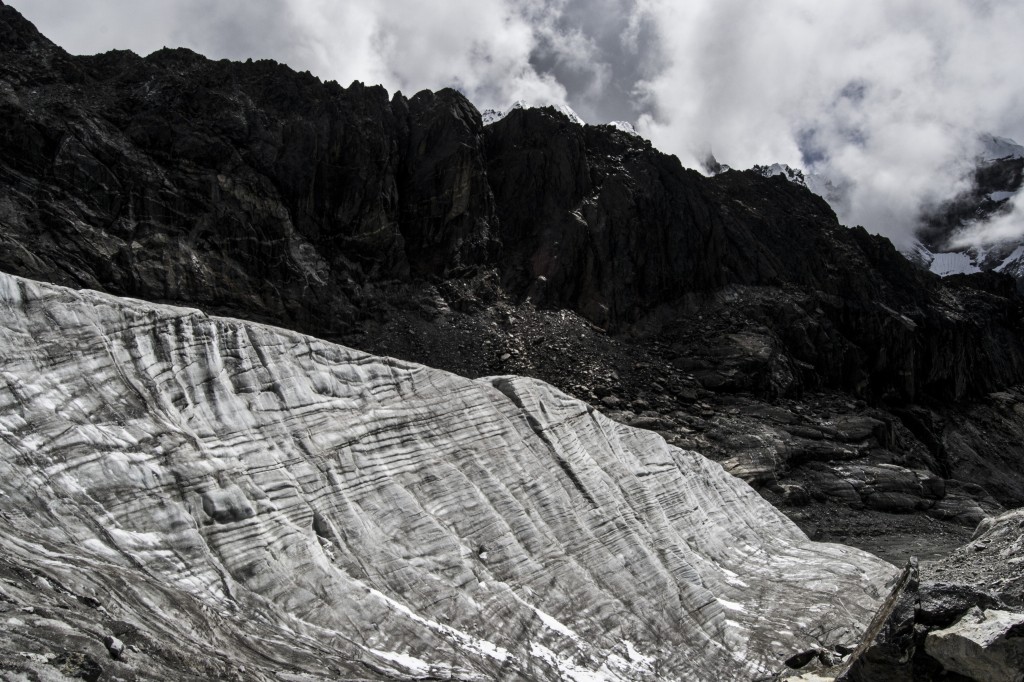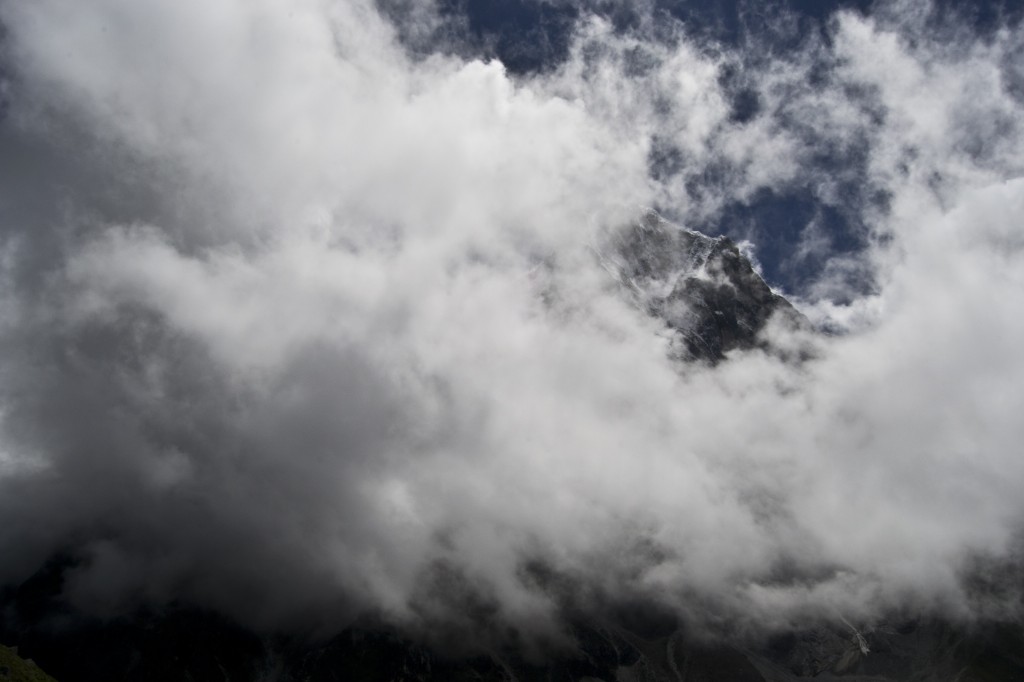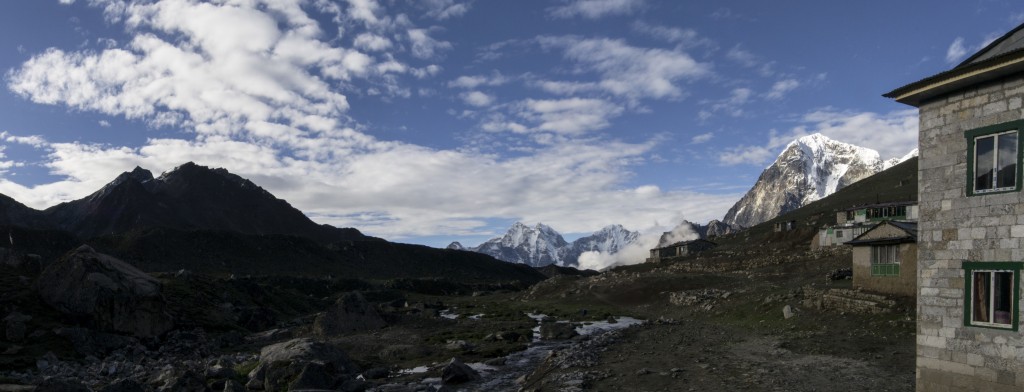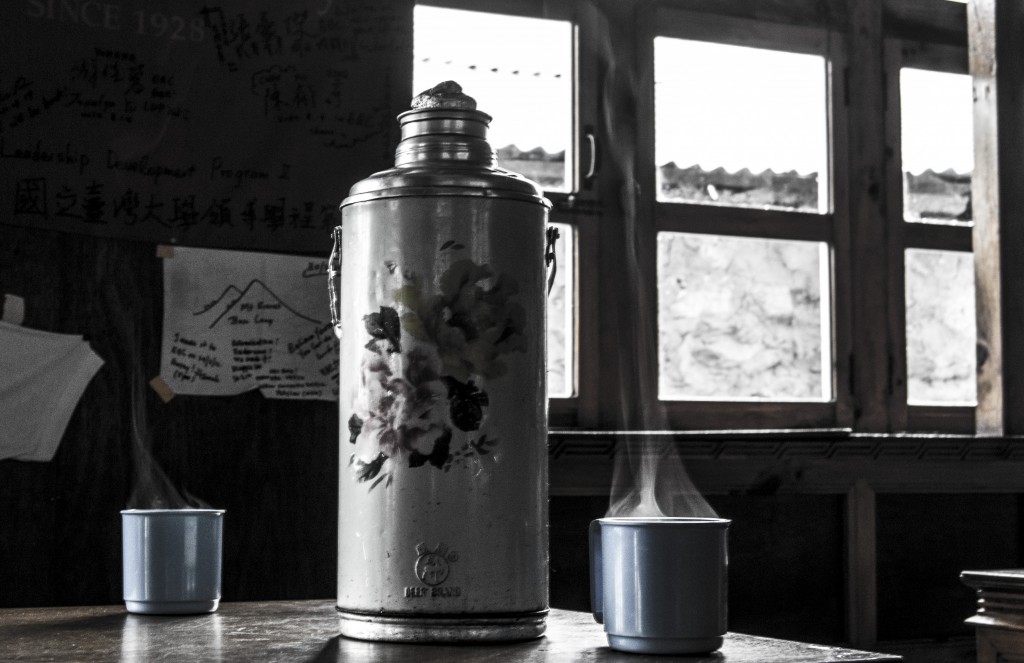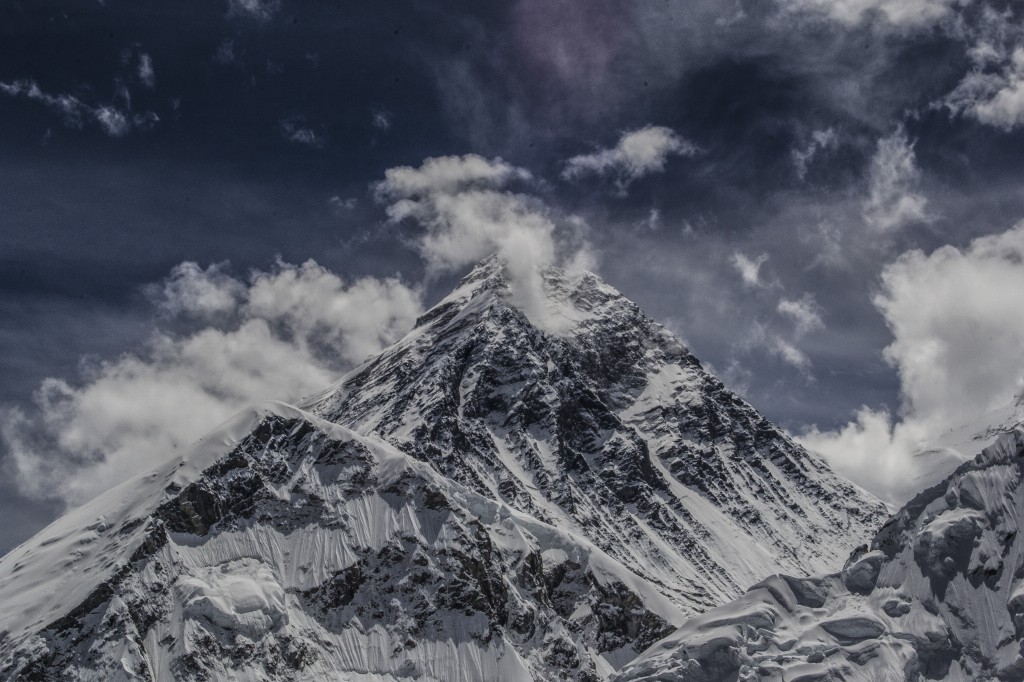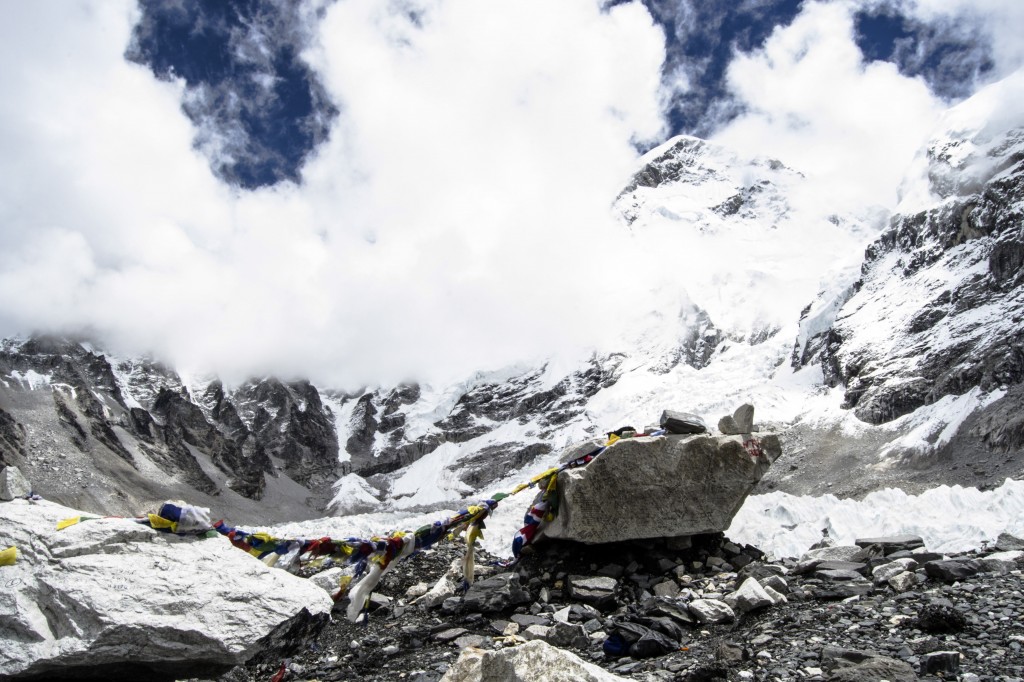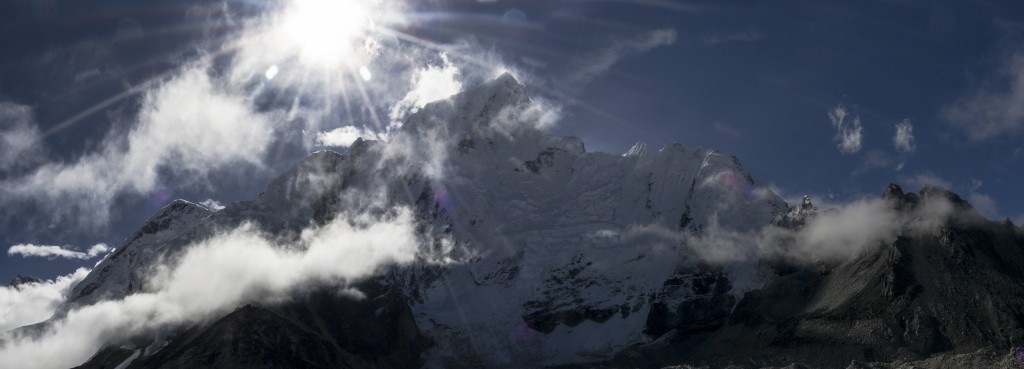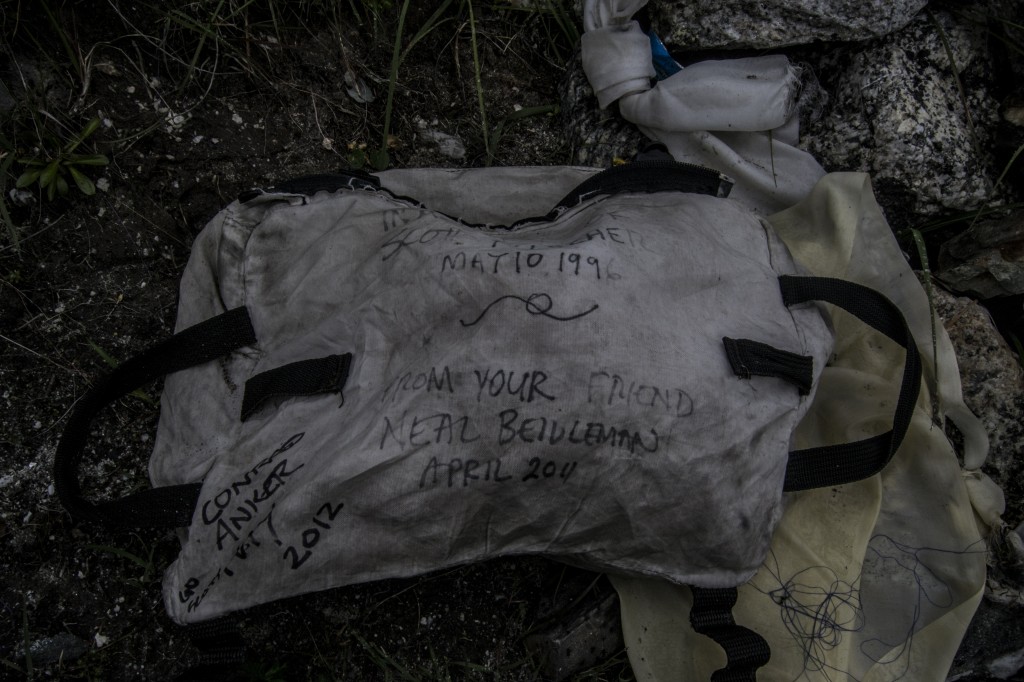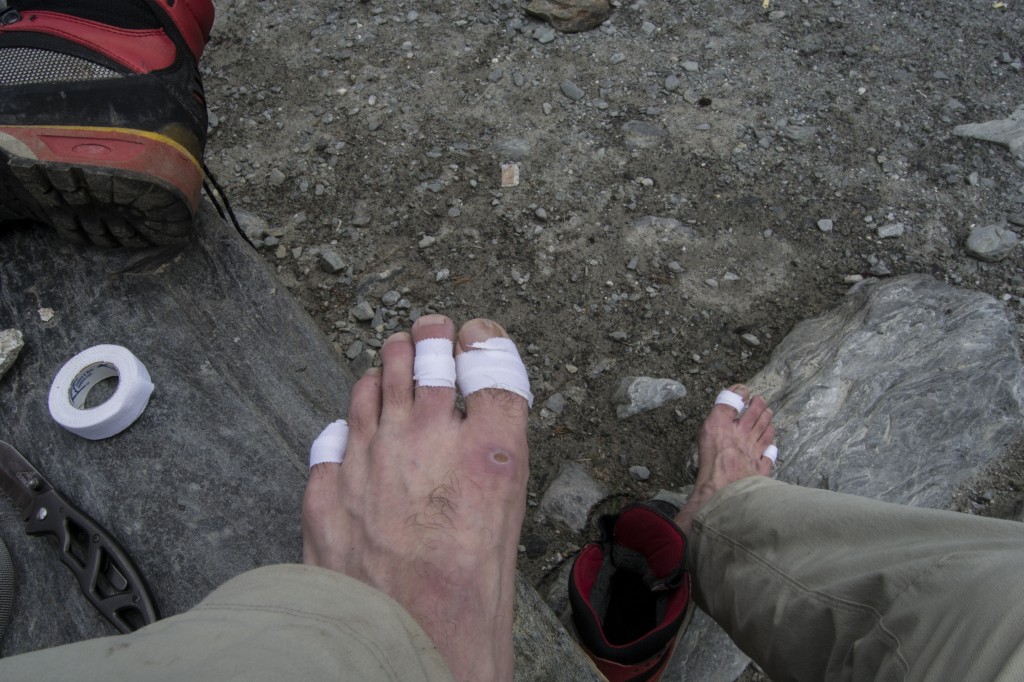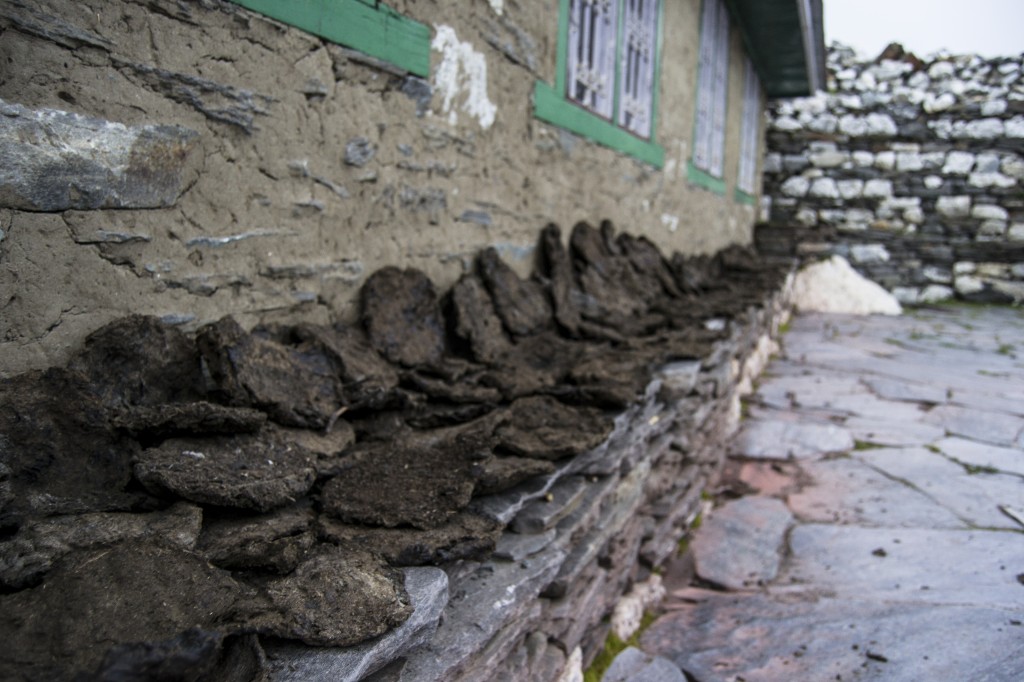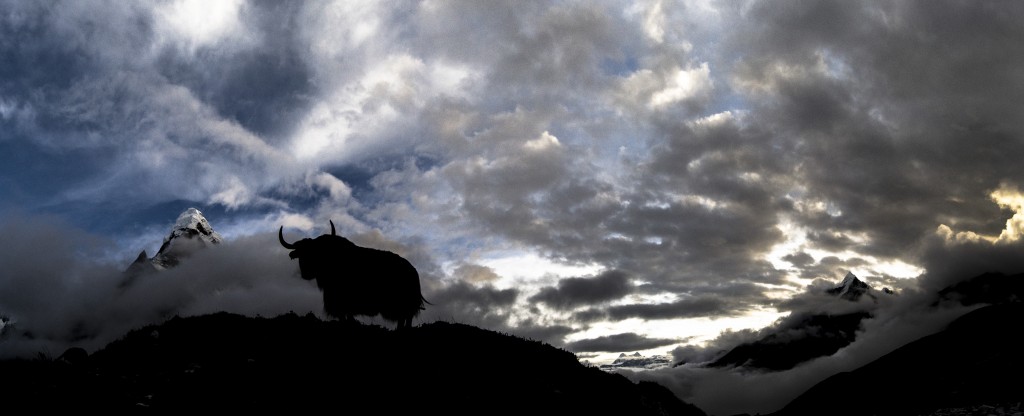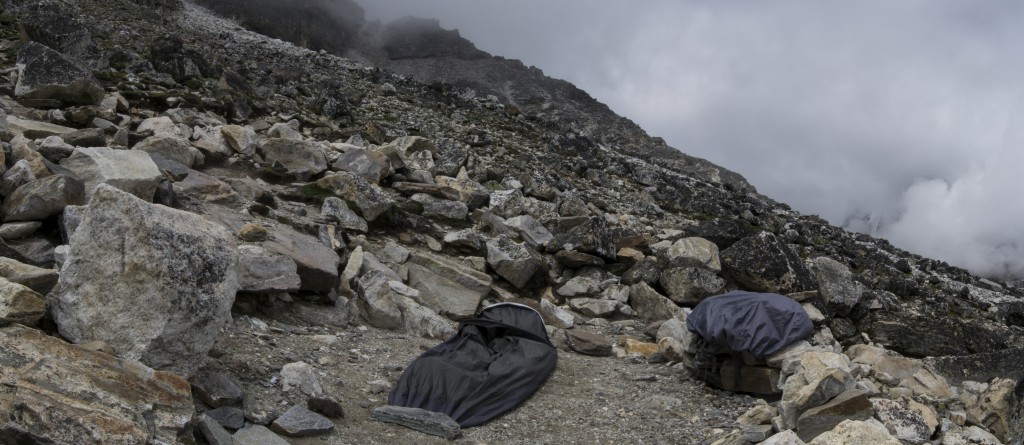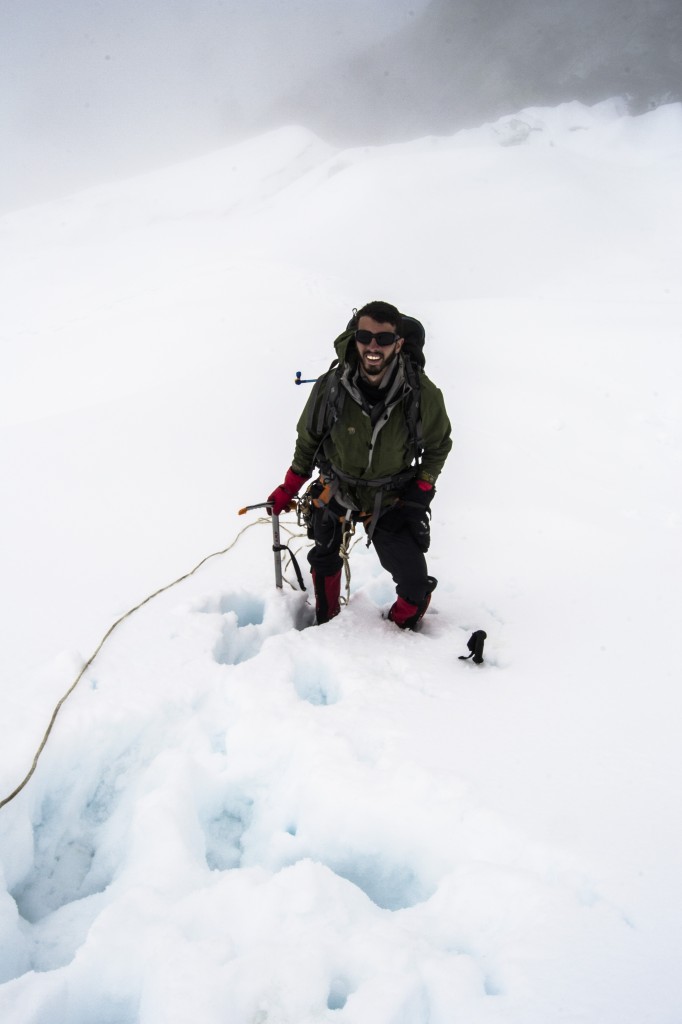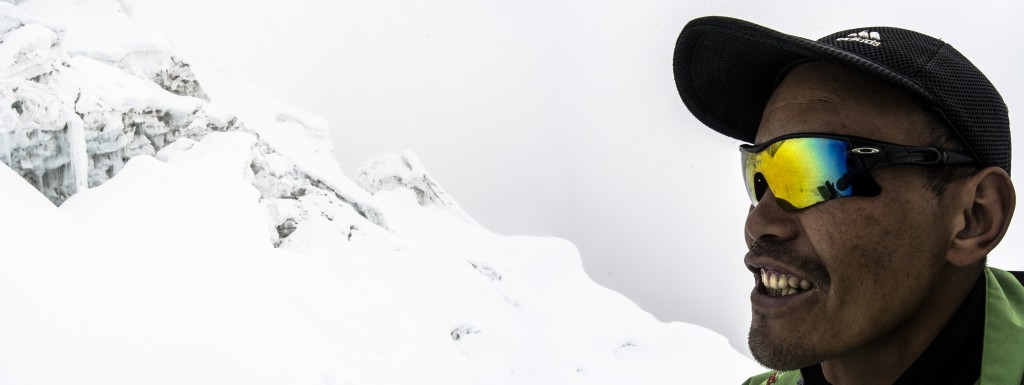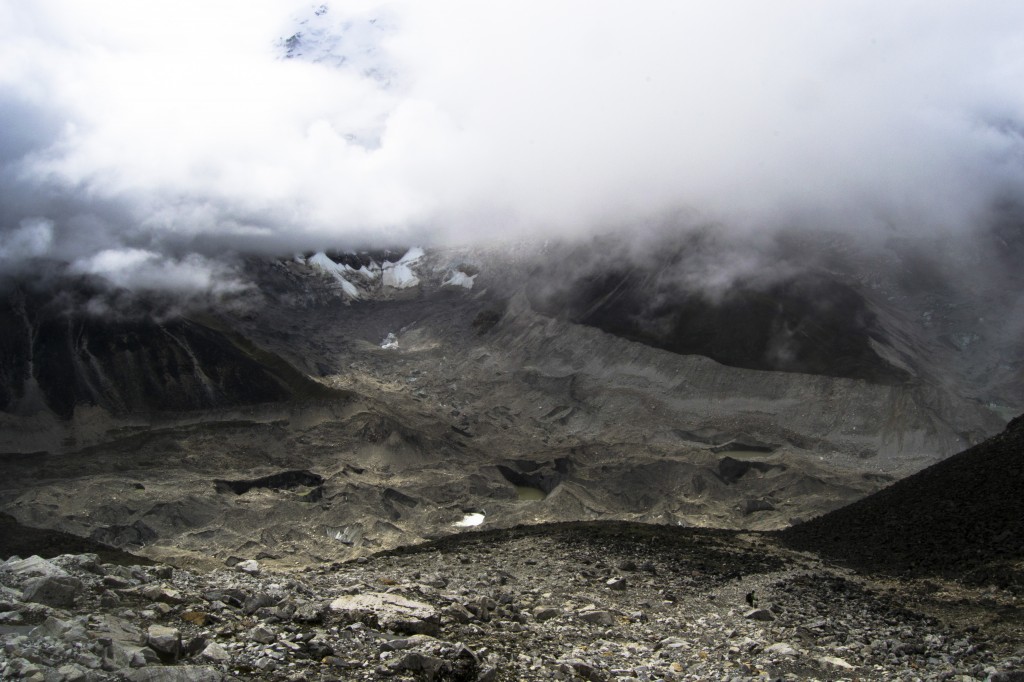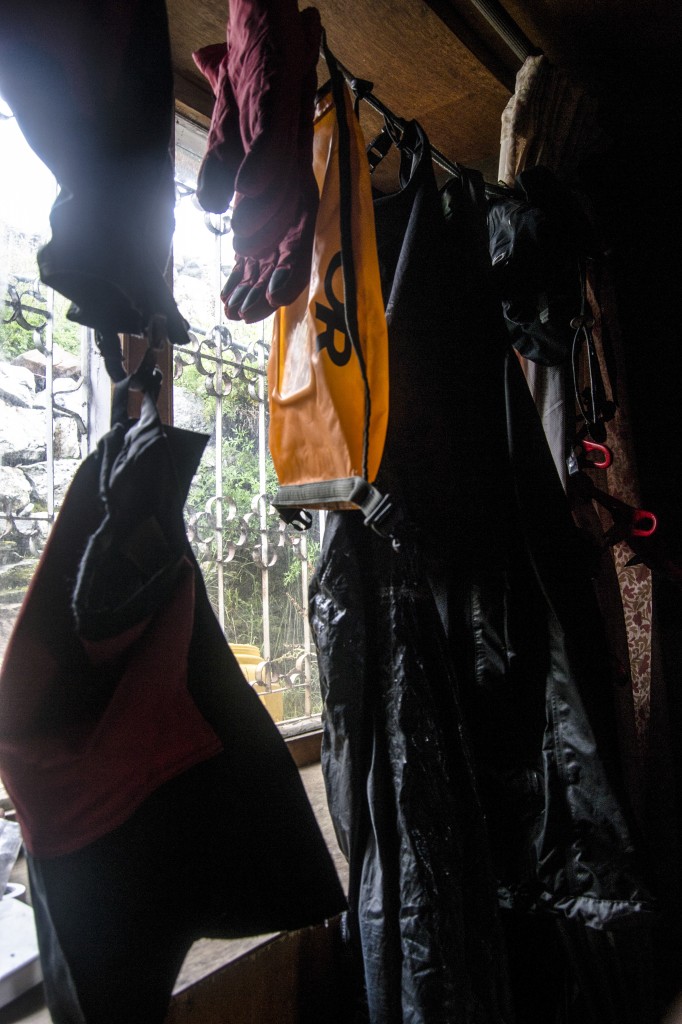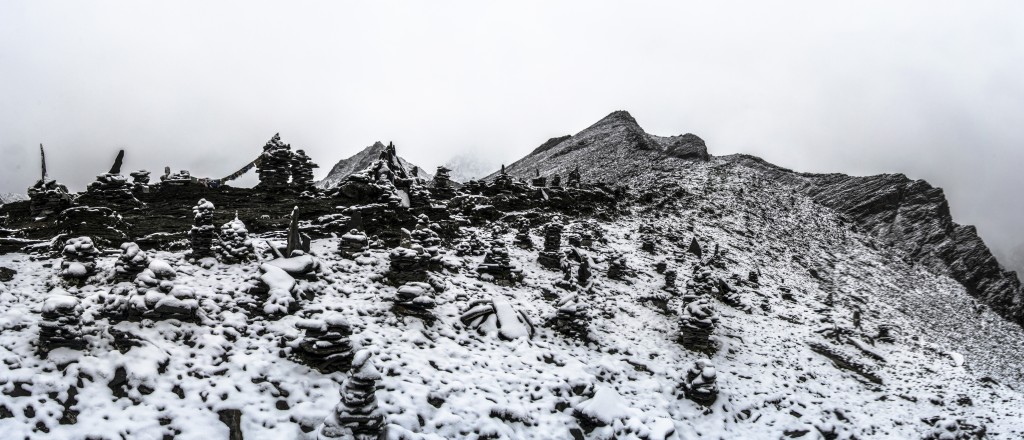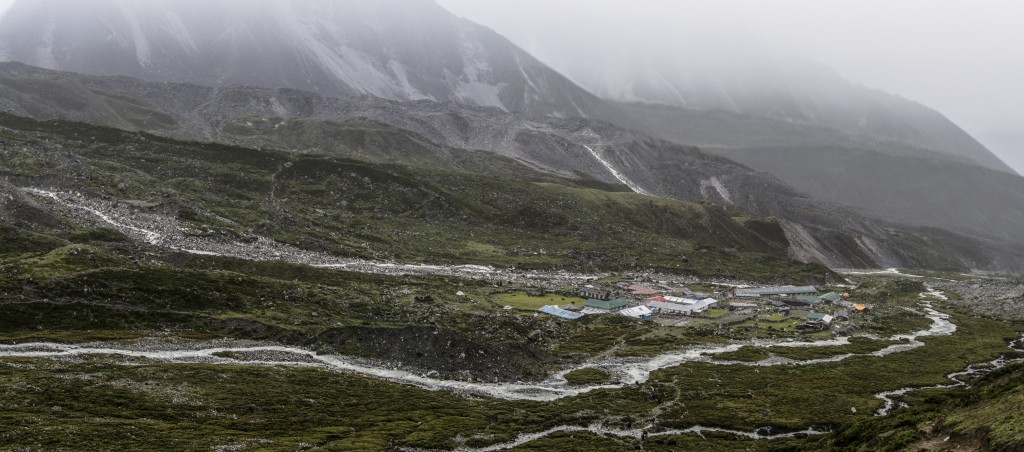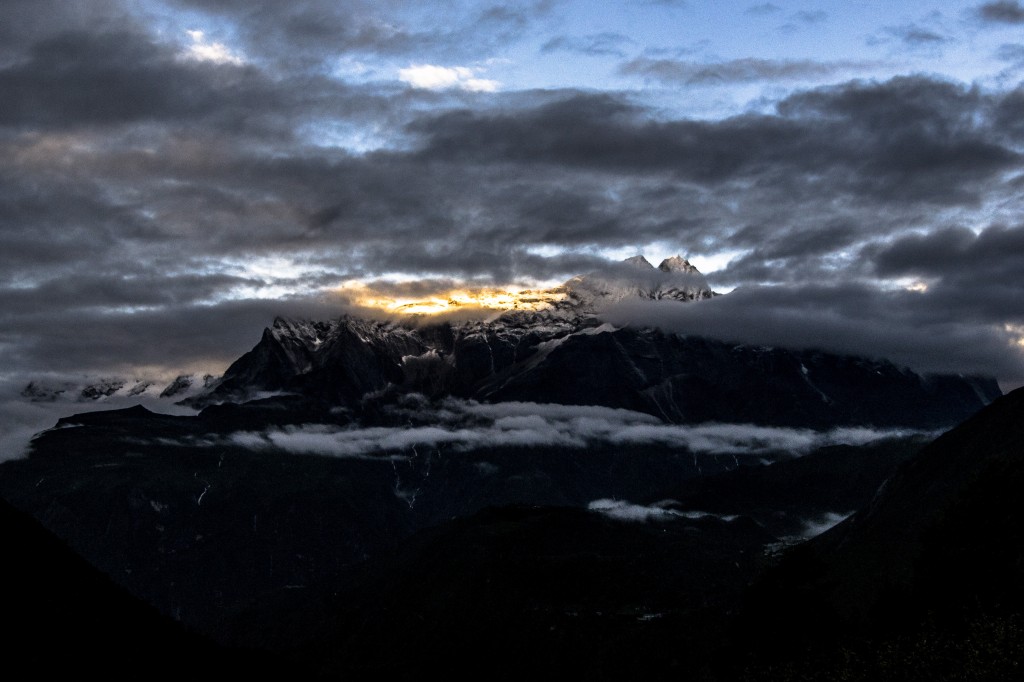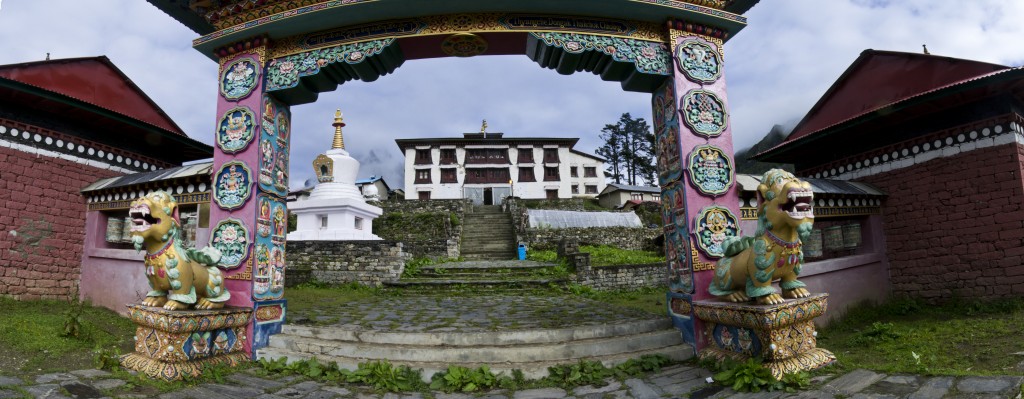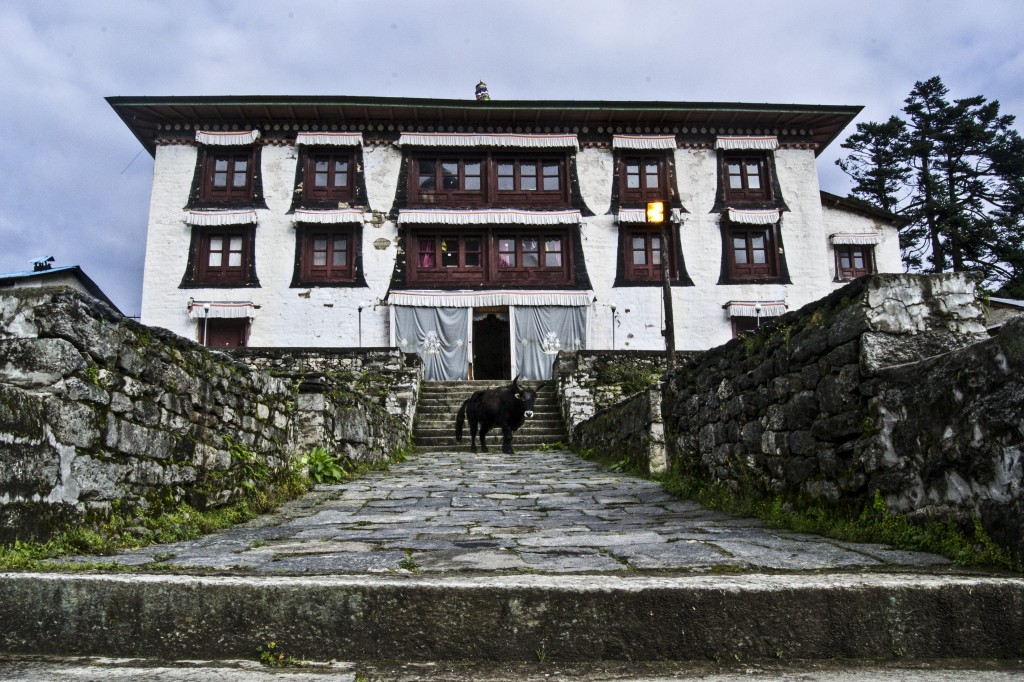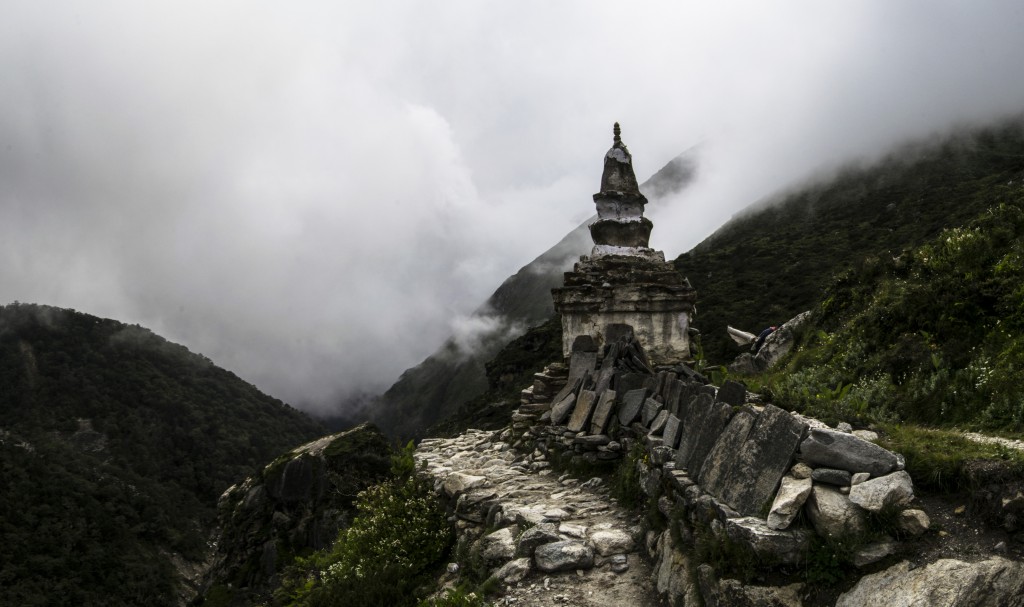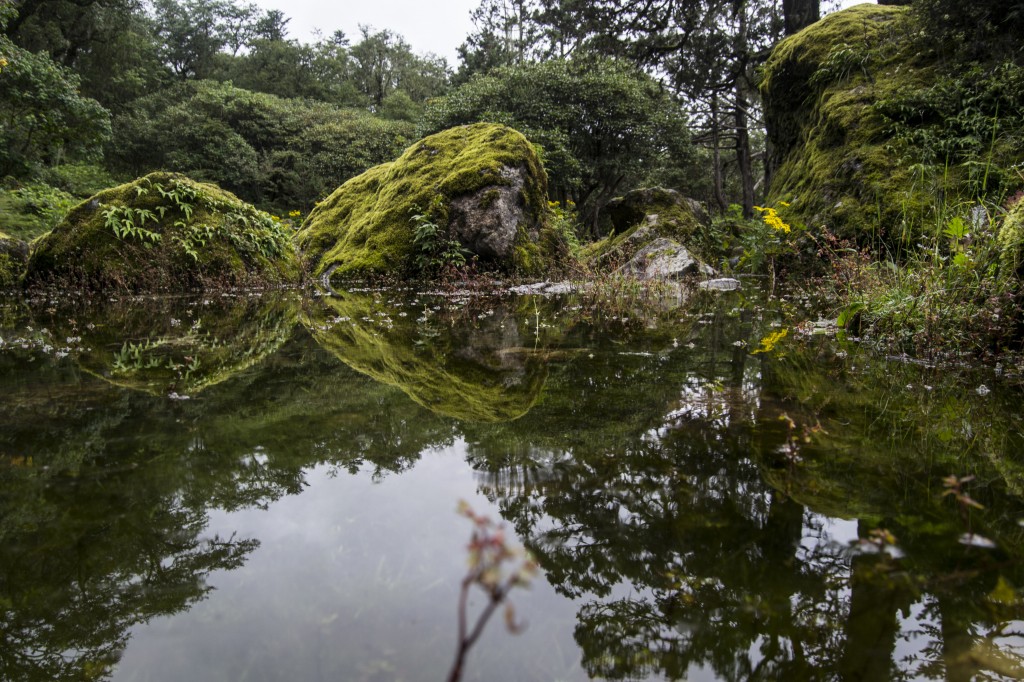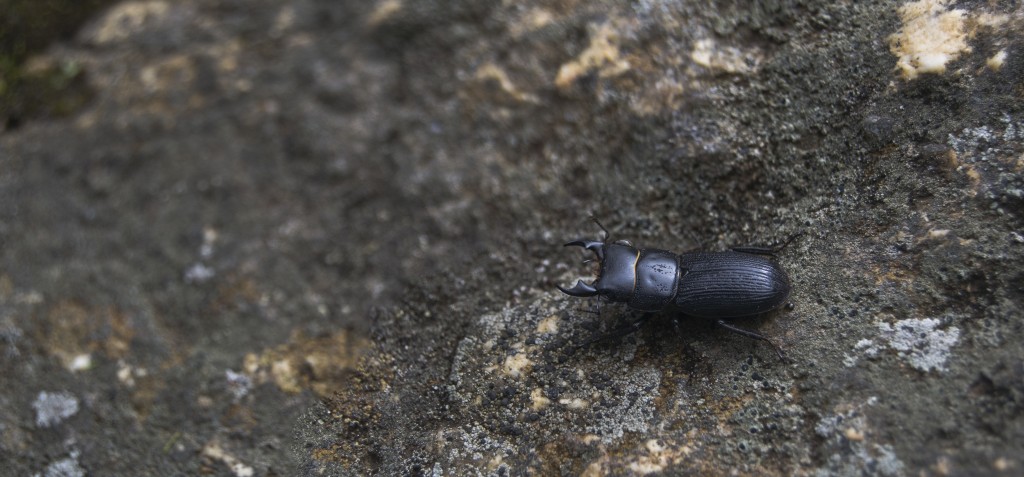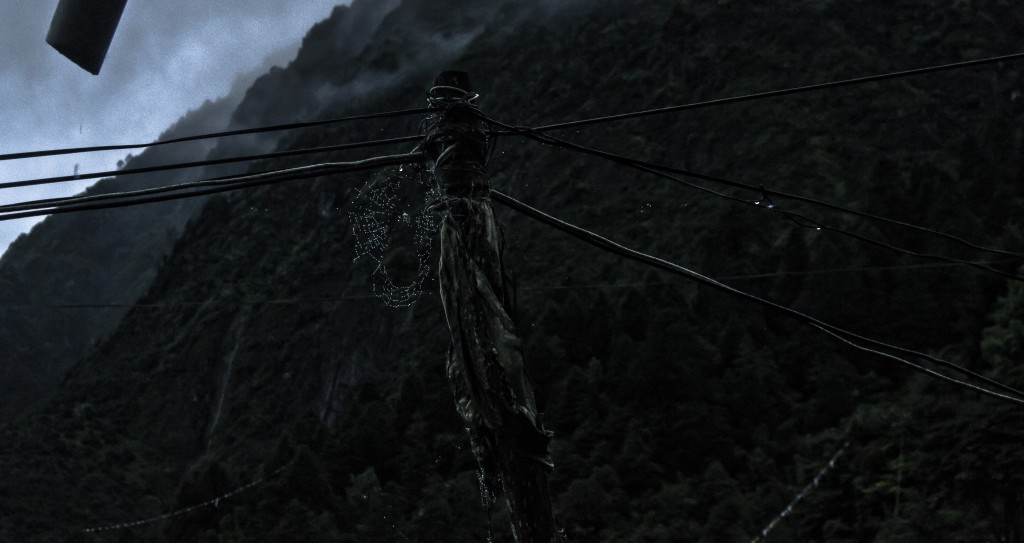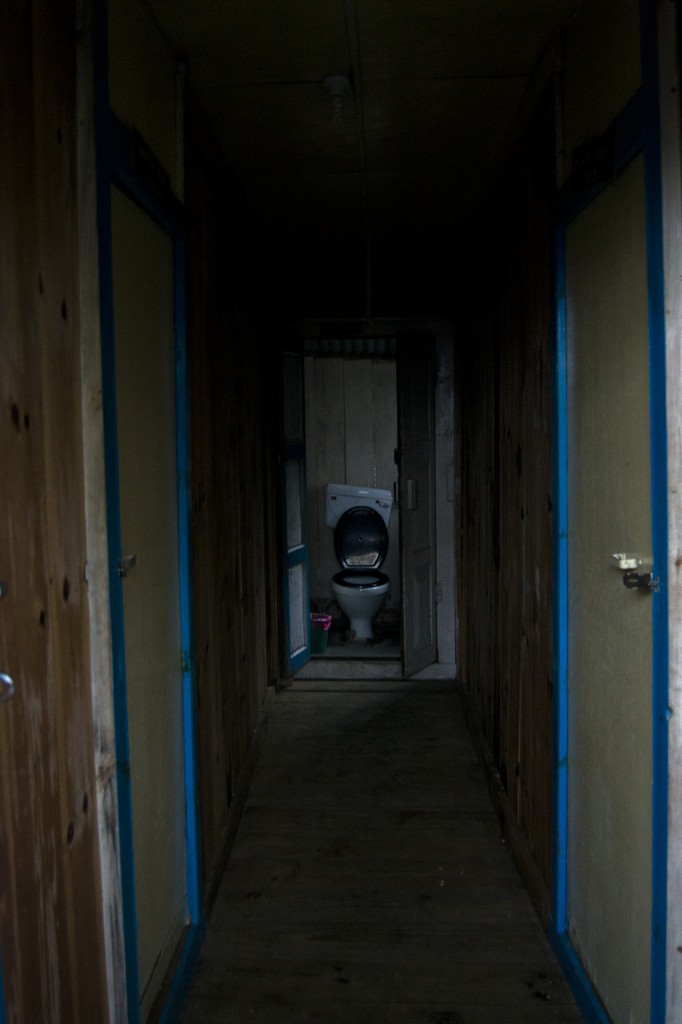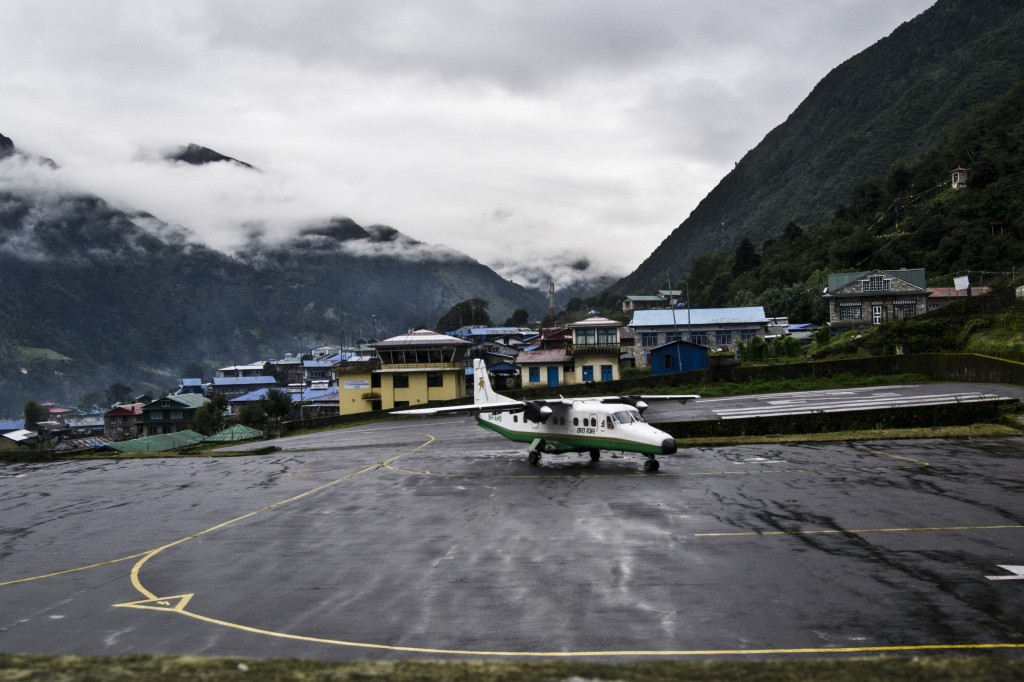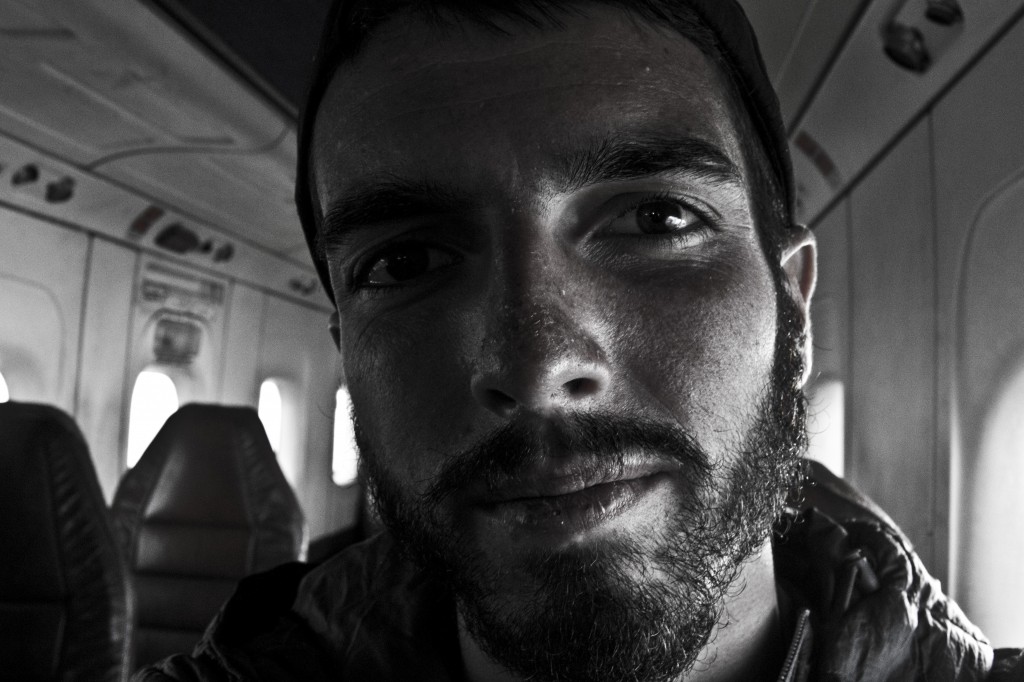4,000ft
08-07-12
“I woke up at 3:30 A.M.”
“The flight was indescribable. . . my words cannot give you the scale and majesty of these mountains. It wasn’t a real place until just now. Waterfalls were falling into the clouds; rivers were raging.”
9,000ft
“The landing was short and furious. . . It looked like we were going to run into the mountainside that said Welcome to Lukla.”
“Time to start walking. I feel all alone here.”
“The walk today wound up and down in elevation. I crossed the river twice.”
“Every tea house is eerily silent, especially after being in bustling Kathmandu.”
“I feel all alone here. There are no tourists, no guide, and no porter. I am alone.”
8-8-12
“. . . the climb really began, straight up the mountain.”
10,000ft
“Trekking alone provides so much freedom. I walk when I want to walk, same with stopping, taking photos, waking up, eating–everything I do at my own pace.”
11,000ft
“A sherpa guide came to talk to me. He said that when he was a porter on Everest in the 70’s; they got a 50 rupee bonus for carrying things from camp 3 to camp 4. . . That’s 50 cents.”
8-9-12
“It was pretty clear really early in the morning, but now there are clouds all over the mountains. They come up so fast. In a few minutes it will go from really clear to extremely cloudy. It’s like the mountains create the clouds. . . great Himalayan smokestacks.”
12,000ft
“I continued to the monastery. The monk opened it just for me. . . It was beautiful and typical of a Buddhist temple.”
“They claim to have a yeti skull.”
“I headed back to Namche. . . I found a monastery where several monks were lining the walls reading ancient Tibetan texts. Apparently this week-long ritual happens every year, and these monks collectively read 108 manuscripts.”
“I asked the man who explained this to me what the most important teaching of Buddhism is. He told me that they are not supposed to hurt or kill any living thing. I said, “Oh, so you don’t eat meat.” He said, “We eat the meat, but we do not kill it.”
8-10-12
“I woke up early before my alarm to find a spectacularly clear day.”
“I felt that I could reach out and grab these mountains.”
“I feel safe down here in the sunlight, amidst the trees and flowers, but the mountains are terrifying. Maybe that is why they must be climbed. This terror sharpens every desire, every yearning, every emotion. It separates the important from the unimportant. And what do I think now? I will find out once I really start climbing. If it is sufficiently terrifying I will find out what is really important. If not I will have an epic adventure.”
“The altitude is starting to make food look nasty. . . Sleep is getting a little bit difficult. Classic altitude. I had dreams that I was slowly suffocating because I couldn’t breathe enough air, and I would wake up panting. . . I can’t sleep on my stomach, because with the pressure on my chest it makes it too difficult to breathe.”
13,000ft
14,000ft
8-11-12
“The sherpa I was talking to was moving the picket for his ox. He said that his ox always fights with the yaks. Mountain world problems.”
“I have much to learn from solitude, and I am not totally alone. The grandfather of the household keeps muttering to me in an indistinguishable language and spinning yak yarn.”
“14,000 foot altitude symptoms: breathlessness, poor sleep, slight loss of appetite. . .”
8-12-12
“I continued down Gokyo Valley for 2 hours. I came to the first lake absolutely surrounded by cairns.”
15,000ft
“I finally ended up at the 3rd and largest lake with Gokyo nestled in the corner.”
“I sat around laughing and joking with the family [at the lodge]. We lit up the yak dung stove and showed each other pictures. It is times like this that I love being here in low season.”
16,000ft
8-13-12
“I woke up at 4:00 A.M. and I hit Gokyo Ri at 4:20. It was so foggy that I had to stumble around in the lake to find the trail.”
17,000ft
“Up, up, breathe, breathe. It was not really too bad. The trail was class 1, but the altitude was high. Breathing was difficult. I started to pass a lot of cairns, and then a false summit, many more cairns, and I could see the real summit. 20 minutes later and I summited.”
“Even though everything was completely covered in fog, the summit was eerily beautiful. Frost covered all the cairns at the top, and the prayer flags also had ice on them.”
“While I was up there the air started to clear, and I got a great view of the lakes but not any of the summits. I waited a while longer to see if the air would clear, but I ended up going back down.”
“I got up and packed my stuff to head to Dhaknak. . . I saw another White guy in the lodge [Chris], and I was in luck – he also wanted to do Cho la Pass. This was great because everyone told me the pass was dangerous, and that I needed a guide. Specifics on the condition of the pass were not available. Everyone simply said it was very dangerous from falling rock, and some people said ‘don’t go’ and that the pass was closed.”
8-14-12
“The next morning at 4:00 A.M. Chris and I left. . . since we were two, we went for it. No guide. We headed out. . .”
“I felt really apprehensive about the pass after everything we heard about it, but after we started climbing everything was really easy. It was just a trail straight up the valley. Slow incline. Chris and I joked, ‘yeah this is really difficult.'”
“After an hour we saw a flag on the ridge. The sun was starting to rise. This must be the top of Cho La Pass. Yeah right that was difficult. We celebrated. Then Chris realized that maybe this wasn’t Cho La Pass.”
“So we followed the trail through the valley to a wall, maybe 45 degrees. It was all loose rock covered in frost and a thin layer of snow. Large boulders were precariously propped above. This is Cho La Pass. Chris took the lead for the first half. The rock was so small and loose, every step was unstable. Rocks were begging to fall. Eventually, after I thought I was going to die for the second time. I decided it would be better to traverse left onto larger rock. Chris followed, and I realized that we had gone far up steep loose rock whereas a trail split off about 50 feet below.”
“We tenuously traversed back to the trail, and it wasn’t bad, although we still had to navigate some ice and snow. We reached the top. . .”
“I looked over the other side of the pass where a huge glacier awaited. No trail. . . search for solution. map. map. map. Is there a glacier after Cho La Pass? Is this Cho La Pass? Yes, there is a glacier after Cho La Pass. Map reads: ‘Extreme crevasse danger stay to left side.’ . . . which side is left side? The left side going east or west? Genius map maker. I decided we should go on the right side. The left side looked more sketchy. There was a glacial pond right under the pass and a couple more to the left. Also, if we went left we would have to walk all the way around the glacier in order to begin moving east.”
“So, after relaxing for a couple of minutes and stressing about our immediate future and possible impending doom, I donned sunglasses to avoid becoming snow blind. . . We had to climb up the rock to the right to be able to transition onto the glacier. I climbed up on solid rock, and I was in the process of pushing loose rock down onto the glacier when my feet were taken out from under me by a miniature landslide. I’m fine.”
“We easily traversed to the glacier after this. It was a little scary. All we could do was stay up the hillside, and I probed with my trekking poles for crevasses. . . Right when we got to the far end of the glacier it started popping and moaning.”
“So we hurriedly tried to navigate the 60 foot slanting ice face to the valley floor. I lost my footing and used a trekking pole and my hands to slow and eventually stop my slide, which could have been bad.”
“I had gashes in both my hands from the ice and gravel but nothing too bad.”
“We continued to the bottom of the glacier uneventfully and the whole beautiful valley spread out before us . . . We could see a village and a trail in the distance. Civilization! Thank you God.”
“So Chris and I walked and walked and walked. We found the trail and walked. We reached a small village, took a break, and basked in the glory of surviving Cho La Pass and the fact that we weren’t lost in the Himalayas.”
“From the village we walked. We walked fast, for two hours until we arrived at Lobuche.”
8-15-12
“The plan is to wake up when I can. I might be too tired from yesterday’s epic to get up at 4:00 again. My plan is to head up to Kala Patthar if it’s clear and go to Everest Base Camp if it’s cloudy. I woke up at 4:00 A.M. and it was clear skies. I could see the stars, but I couldn’t muster the resolve to get out of bed. I slept in . . . and headed to Gorak Shep at 7:30ish. . . I would walk alone.”
“I arrived in Gorak Shep, threw my stuff in a room, and headed up Kala Patthar. I underestimated it. The elevation made it a long slow haul. “
18,000ft
“It took me about an hour and twenty minutes to summit. And here it is. . . the feeling of missing those I love, the feeling of how much work I have put into arriving at this moment, the amount of convincing to get me to Nepal, The amount of gear purchased, the amount of intense breathing to be able to climb to this summit. And here is Sagarmatha. Not here to disappoint, but to completely overwhelm. . . Every photo of every mountain, every painting is a contrivance, a copy, a fake of this majesty.”
8-16-12
“Everyone is heading down but not me. I’m headed to Mount Everest Base Camp. . . Time to do what I really came here to do. . . Everyone told me that the walk from Gorak Shep to EBC was a walk in the park. So I headed off with easy expectations in my head.”
“I walked easily on the main trail. Eventually I hit the glacier and the trail disappeared. No cairns. I turned around a couple of times and couldn’t pick it up. I went to the ice fall and did some impromptu (but very planned) ice climbing on a serac. Then I moved further and further down the glacier.”
“The gravel topping the ice made looking for the base camp marker very frustrating. I would place both trekking poles, take one step, and everything would slip. On top of this, the glacier was huge. There was no way to intelligently find the marker because there were signs of human life everywhere. Decades of people camping all over this glacier made it a minor human trash can. I kept stumbling and falling and slipping on hill after hill of gravel and ice. If I just climb that hill I’ll see it. If I just go a little further I’ll see it. The tip of one of my trekking poles fell off. That rock, maybe that’s where base camp is. My camera fell out of my bag and shattered my filter. Maybe base camp is in the icefall. I head that way. The tip of my other trekking pole fell off. Clouds gather in the east. Ominous creaks emanate from the glacier. Crashes echo out of the clouds looming in the very near east. Where the freak is base camp! I headed back becoming scared for my life, hungry and tired from the hours I had been out here. This was the REASON I CAME HERE. WILL I REALLY NOT SEE THE BASE CAMP MARKER? Nothing I can do about it; I’m at the end of the glacier amidst the seracs of the icefall. Time to head back. I stayed near the glacier stream and then realized it would be easier to head back across the high points. I was exhausted by all of my stumbling around and jumping over glacial streams at 17,000 feet. After walking back for an hour – what prayer flags! And two rocks. I FOUND BASE CAMP! I had walked over an hour past it down the glacier when the base camp marker was relatively early on. In fact, it was a really easy path from the base camp stones back to the trail. I was both aggravated and relieved that I found it.”
“I headed back to Gorak Shep. I rested for a while, ate and drank to recover from the morning/afternoon’s ridiculous events, and headed to Lobuche. Nature wasn’t done with me yet. On the way to Lobuche one of the little foot bridges was out and the water was raging. Some ice boulders had formed a natural dam. If I didn’t cross here I would have to take a huge detour on no-trail terrain. I decided to go for it. I slipped and slided along the icebergs until I was half way into the river. The smaller ice boulders didn’t touch the bottom, and I couldn’t step on them or they would sink. I saw gravel falling from the top of the glacier above me. I needed to hurry. I was in a vulnerable spot for ice or rock to fall. I took a big step to the next large ice block, and it flipped. I was waste deep in freezing water. I scrambled hands and knees back up and across the rest of the ice until I got to the other side.”
“I was proud, not proud but full of pride. What now nature? What else do you have for me? I will survive you. Five minutes later, walking in my soaked boots and pants, it started raining and the wind started blowing. The pride faded and I started thinking about how to survive.”
8-17-12
“Today it’s time for Chukkung. The anticipation of this leg of my trip has been marked with anxiety. I’ve already had too many crazy things happen, and Island Peak is supposed to be the most adventurous of all of them. I really hope my guide shows up. . .”
“The way to Chukkung was pretty uneventful. The first half was down the valley. The second half was back up another valley to the village. It is always good to see civilization when trekking alone for hours with no sign of human life. I really miss people and the outside world. It gets so lonely, but I’m almost done.”
“When I arrived at Chukkung I met a guy from Norway. . . He had just gotten back from Island Peak High Camp. He bailed because of altitude headaches. However, their partner (a local of Chukkung) had started getting really sick on the way back. They ended up leaving him a bottle of water and some crackers. They took his load of gear and peaced out on him. They had already been waiting for him for hours when I got there, and they soon took a stretcher and went to get him. They eventually came back with him on the stretcher, and the Norweigian guy’s guide payed 13,000 rupees to get out of responsibility/get the porter to a hospital. In the mean time, my Island peak guide (Karma Sherpa) showed up. Thank God.”
8-18-12
“We left at 9:15 today; weather is iffy. It’s really cloudy and sprinkling every once in a while. I just have a bad feeling about this trip. . . This is the capstone though.”
“I felt really good when we got to high camp. My map says it’s over 18,000 feet, and I have no AMS symptoms. I can’t stop thinking about the climb tomorrow. The what-ifs. The things that could go wrong. The joy I would get from walking onto the summit.”
“In general the evening wasn’t good. I spilled ramen all over my pants – not good since it’s the only real pair of pants I have and they won’t be dry before tomorrow. Also it started raining consistently at dinner time. So, I’m trying to clean my pants and keep myself dry, and there is not cover from the rain except in my cramped bivy sack. I open it to find that water has pooled on the zipper, and a puddle awaits me at the head of my sleeping bag; mopped up with dirty pants and tried to settle in comfortably. The ground is cold and rocky and I have to regularly shift into specific positions to stay comfortable. Back… right side… back… left side. My down jacket is wet and so is the top of my sleeping bag. I put my jacket under my butt to buffer the icy ground. I also had a problem with condensation, and air flow. If I kept my bivy all the way closed the condensation would get everything wet, and it was hard to breathe recycled oxygen at 18,000 ft. But if I left my bivy open things got wet even faster. I never found a happy medium. I maybe slept one hour in four minute intervals.”
8-19-12
“So, I got out of my sloppy bivy at 4:45. Thank goodness it wasn’t raining, only misting. I got my gear ready to go as Karma made porridge for breakfast. As I was sitting there, I thought about my position in life. I was sitting in darkness and mist at 18,000 feet. My hand had a trail of snot on it and I didn’t care. There was some wet insect that had died and was plastered to my spoon, and I didn’t care. I hadn’t showered in ten days, and I didn’t care. My nose was sun burnt. My lips were chapped. There was straight dirt mixed with my porridge. When was the last time I had a good meal?”
19,000ft
“At 6:00 our climb began, up through class 3 rock. Up, up, up through rock to 6,000 meters. This is where we met the glacier. We strapped on our crampons, I put on my gaiters, harness and mitts. I put my ice axe through one of the gear loops on my harness.”
“The snow was soft, way too soft. Karma was leading, and he was struggling – sinking sometimes knee deep sometimes hip deep, but we were making progress.”
20,000ft
“That is until we came to a ridge. On the other side of the ridge was a huge crevasse. Karma said it was impossible to cross. I suggested we try lower on the ridge. He agreed. We hit the crevasse again. Karma said that it was impossible to go further. I didn’t want to stop. I asked the same question again and again; ‘Are you sure there is no other way?’ . . . Ke Garne (What to do). I realized that I failed the peak. And, in failure, I realized that I hadn’t even wanted to climb the peak. I wanted to accomplish a summit. I wasn’t climbing Island Peak because that’s what I enjoy.”
“Nevertheless, as I stood on that glacier, wading through snow amidst the world’s giants, I was in a different world. A world few wandered to. A world that was far far away, up, up, up. A place few are privileged to see; misty, snowy peaks at the top of the world. I must come back. If I failed on Island Peak it is time for a mountain climbing paradigm shift.”
“I dried all of my things and ate at Chukkung.”
8-20-12
“Last objective today. Chukkung Ri to finish off the things to do in Sagarmatha. I also heard of a peak behind it called Chukkung Tse that goes to 19,000 feet, but we’ll see how things go. I tried not to underestimate Chukkung Ri, but I did. I thought it would be easy and it was, but it was also long. And up high it was snowing softly.”
“I climbed into a large bowl and then up. Up a ridge to the left looked like Chukkung Ri maybe 50 meters higher than where I stood, and to the right was Chukkung Tse – at least I thought so. It towered much higher, but the climb looked fairly easy and non-technical.”
“I hit the main summit first and got some prayer flags and a breathtaking view of the snow coming down everywhere. I didn’t stay long. I started down the ridge and then the long scramble up the uneven ridge to Chukkung Tse.”
“It started snowing harder. I was hurrying, out of breath because I was scared of getting stuck at 19,000 feet alone. There was a couple of inches already on the ground and more was coming. The summit marker was small, a few pictures and get the freak down.”
“My last objective, I am finished.”
“I went down to Chukkung ate, packed, and set off for Thengboche in the rain. The way down the main valley was really interesting. Since I went in a huge loop, I had never seen it before. I stopped in Pangboche for lunch and continued the long downhill to Thengboche.”
“I arrived after a total of about four hours. . . I ended up talking to a guy from Australia and a guy from the UK until long into the night (around 9:30); it is the latest I have been up since being in the mountains.”
8-21-12
“Woke up early and saw that it was clear and beautiful out. It was really great to chill and watch the sunrise on the mountains that I was leaving. I just stood there and looked at them. God is a master.”
“I left at eight. Down one hour, up one hour, flat one hour. I finally ran into familiar territory – the turn-off for Gokyo Valley 45 minutes outside of Namche.”
“I continued on. Another 30 minutes and I’m in Namche, moving at a crawl. My feet were killing me after so much downhill, big blisters formed on my left pinky toe and right big toe. I went to the same lodge as the last time I was in Namche. I ordered food and tea. Ah civilization.”
8-22-12
“Long slog to Lukla today. I left at 9:00 and arrived in Lukla about 4:00. The last two hours it rained continuously. Somewhere along the way I picked up a leech on my pants.”
“The old woman at the lodge that I stayed at was so sweet. She hooked me up with extra blankets and stuffed me full of dal bhat. I slept deeply and would panickingly wake up to make sure I wasn’t late. I was afraid of missing my flight the next day.”
8-23-12
“I was the first one at the airport, which didn’t open until 6:00. 2 Tara planes came before my Sita plane showed up. We all got in silently hoping that we weren’t about to die [on the world’s most dangerous runway].”
“The engines started and we hurried at a steep angle down the runway. We were off the runway hurtling down for a split second and then we started to pull up.”
“What a ride. Above the clouds the mountains stood immoveable. Goodbye Himal. I will do everything I can to meet you again. You are beautiful. “


